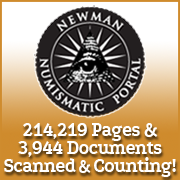
About UsThe Numismatic Bibliomania Society is a non-profit organization devoted to the study and enjoyment of numismatic literature. For more information please see our web site at coinbooks.org SubscriptionsThose wishing to become new E-Sylum subscribers (or wishing to Unsubscribe) can go to the following web page link MembershipThere is a membership application available on the web site Membership Application To join, print the application and return it with your check to the address printed on the application. Membership is only $20 to addresses in the U.S., $25 for First Class mail, and $30 elsewhere. For those without web access, write to: Terry White, Treasurer
AsylumFor Asylum mailing address changes and other membership questions, contact Terry at this email address: terrywhite5475@yahoo.com SubmissionsTo submit items for publication in The E-Sylum, just Reply to this message, or write to the Editor at this address: whomren@gmail.com BUY THE BOOK BEFORE THE COIN |
- WAYNE'S WORDS: THE E-SYLUM APRIL 17, 2016
- NEW BOOK: THE BAD-ASS LIBRARIANS OF TIMBUKTU
- BOOK REVIEW: A CHISELER’S TRUE STORY
- NEWMAN PORTAL SCANS COL. GREEN GOLD COINAGE PLATE BOOKS
- BUILDING THE D. BRENT POGUE COLLECTION
- MORE ON THE MICHIGAN STAMP AND COIN COMPANY
- NOTES FROM E-SYLUM READERS: APRIL 17, 2016
- QUERY: SILVER PENNY REPORTED FOUND IN SHELL MIDDEN
- FORGERIES AND FAKES AT MOUNT VERNON
- EDWARD DAVID COGAN (1803-1884)
- ARTICLE FEATURES COIN DESIGNER ANDREW LEWIS
- CONFERENCE: BELGIAN NUMISMATICS IN PERSPECTIVE
- THE ROYAL MINT VISITOR EXPERIENCE
- LONDON GALLERY LETS STUDENTS HANDLE ANCIENT COINS
- UK MAN FINDS ROMAN VILLA BENEATH HIS HOUSE
- HORSES ON ANCIENT COINS
- AN EQUESTRIAN QUEEN ELIZABETH II ON COIN
- THE SIGNIFICANCE OF STAMPS USED ON BANK NOTES
- MILLION POUND BANKNOTE AUCTIONED BY SPINK
- SELECTIONS FROM THE POGUE COLLECTION, PART IV
- WAYNE'S NUMISMATIC DIARY: APRIL 17, 2016
- FINNISH MEDALS BY KAUKO RäSäNEN AND HEIKKI HAIVAOJA
- ARTICLE HIGHLIGHTS FIGHT FOR WOMEN ON U.S. BANKNOTES
- NEW AUSTRALIAN BANKNOTE DRAWS CRITICISM
- GOLINO ON MODERN U.S. COIN DESIGN
- THE CUMBERLAND GAP QUARTER LAUNCH EVENT
- STOLEN INVERTED JENNY STAMP REAPPEARS
- BALTIMORE GROUP PLANS NEW LOCAL CURRENCY ISSUE
- BUYERS THRONG TO BUY VIETNAM COMMEMORATIVE NOTE
- EDMONTON REMOVES LAST COIN-OPERATED PARKING METERS
- FEATURED WEB SITE: THE CURRENCY COLLECTOR
Click here to access the complete archive
To comment or submit articles, reply to whomren@gmail.com
WAYNE'S WORDS: THE E-SYLUM APRIL 17, 2016
We have no new subscribers to report this week. Our count stands at 1,964 subscribers. Please welcome our newest advertiser, Harry Labstain Rare Coins. Thank you for your support!
This week we open with two new books, an update from the Newman Numismatic Portal, background on assembling the Pogue Collection, and several notes from E-Sylum readers.
Other topics this week include dealer Ed Cogan, medallist Mico Kaufman, coin designer Andrew Lewis, stamps on banknotes, Finnish medals, the Million Pound Banknote, the Cumberland Gap quarter and the stolen inverted Jenny.
To learn more about W. F. Fratcher, Lady Laverly, dust jackets, shell middens, Washington medals, the Pop Art Canada Goose, horses on ancient coins, the Great Central Fair and the bad-ass librarians of Timbuktu, read on. Have a great week, everyone!
Wayne Homren
Editor, The E-Sylum
NEW BOOK: THE BAD-ASS LIBRARIANS OF TIMBUKTU
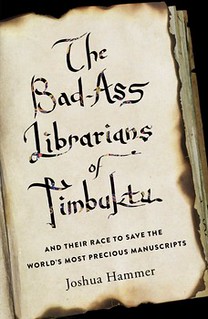 For custodians of the ancient heritage of the Middle East and North Africa, the recent rise of Islamist extremist groups has posed a dire
challenge. Since its seizure of the historic Iraqi city of Mosul in early 2014, Islamic State has pillaged and demolished mosques, shrines, churches
and other sacred sites across the region. The group continues to launch “cultural cleansing” operations from Tikrit to Tripoli.
For custodians of the ancient heritage of the Middle East and North Africa, the recent rise of Islamist extremist groups has posed a dire
challenge. Since its seizure of the historic Iraqi city of Mosul in early 2014, Islamic State has pillaged and demolished mosques, shrines, churches
and other sacred sites across the region. The group continues to launch “cultural cleansing” operations from Tikrit to Tripoli.
In this grim procession, there have been occasional victories for culture over extremism, like the recapture last month of the ancient Syrian city of Palmyra, which may now be restored to something of its previous glory. A less familiar case of cultural rescue features an unlikely hero: a 51-year-old book collector and librarian named Abdel Kader Haidara in the fabled city of Timbuktu, in the West African country of Mali.
The story begins in April 2012, when Mr. Haidara returned home from a business trip to learn that the weak Malian army had collapsed and that nearly 1,000 Islamist fighters from one of al Qaeda’s African affiliates, al Qaeda in the Islamic Maghreb, had occupied his city. He encountered looters, gunfire and black flags flying from government buildings, and he feared that the city’s dozens of libraries and repositories—home to hundreds of thousands of rare Arabic manuscripts—would be pillaged.
Mr. Haidara knew that many of the works in the city’s repositories were ancient examples of the reasoned discourse and intellectual inquiry that the jihadists, with their intolerance and rigid views of Islam, wanted to destroy. The manuscripts, he thought, would inevitably become a target.
A few days after the jihadist occupation began, Mr. Haidara, who worked full time as a book restorer, archivist and fundraiser, met with his colleagues at the office of the Timbuktu library association, which he had formed 15 years earlier. “I think we need to take out the manuscripts from the big buildings and disperse them around the city to family houses,” he told them, as he recalled the conversation for me two years later. “We don’t want them finding the collections of manuscripts and stealing them or destroying them.”
Months earlier, the Ford Foundation office in Lagos, Nigeria, had given Mr. Haidara a $12,000 grant to study English at Oxford in the fall and winter of 2012. The money had been wired to a savings account. He emailed the foundation and asked for authorization to reallocate the funds to protect the manuscripts from the hands of Timbuktu’s occupiers. The money was released in three days. Mr. Haidara recruited his nephew, and they reached out to archivists, secretaries, Timbuktu tour guides and a half-dozen of Mr. Haidara’s relatives.
The result was a heist worthy of “Ocean’s Eleven.” They bought metal and wooden trunks at a rate of between 50 and 80 a day, made more containers out of oil barrels and located safe houses around the city and beyond. They organized a small army of packers who worked silently in the dark and arranged for the trunks to be carried by donkey to their hiding places.
Over the course of eight months, the operation came to involve hundreds of packers, drivers and couriers. They smuggled the manuscripts out of Timbuktu by road and by river, past jihadist checkpoints and, in government territory, suspicious Malian troops. By the time French troops invaded the north in January 2013, the radicals had managed to destroy only 4,000 of Timbuktu’s nearly 400,000 ancient manuscripts. “If we hadn’t acted,” Mr. Haidara told me later, “I’m almost 100% certain that many, many others would have been burned.”
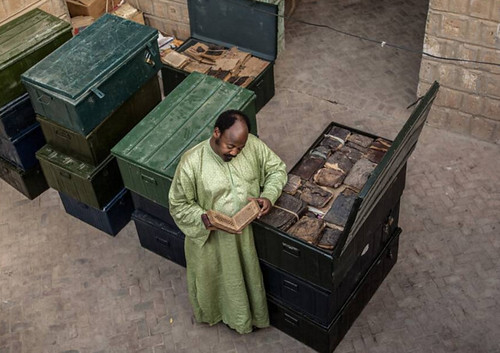
To read the complete article, see:
The Librarian Who Saved
Timbuktu’s Cultural Treasures From al Qaeda
(www.wsj.com/articles/the-librarian-who-saved-timbuktus-cultural-treasures-from-al-qaeda-1460729998)
For more information, or to order, see:
The Bad-Ass Librarians of
Timbuktu (http://books.simonandschuster.com/The-Bad-Ass-Librarians-of-Timbuktu/Joshua-Hammer/9781476777405)
To read the earlier E-Sylum article, see:
THE SECRET OF TIMBUKTU'S MANUSCRIPT RESCUE
(www.coinbooks.org/esylum_v16n10a29.html)
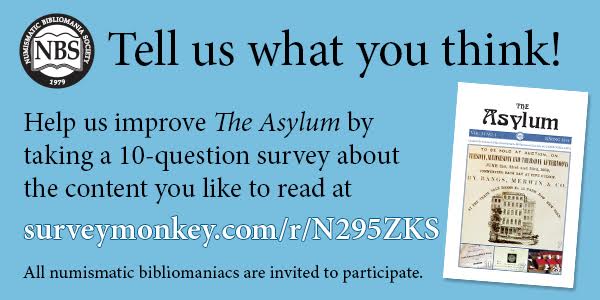
BOOK REVIEW: A CHISELER’S TRUE STORY
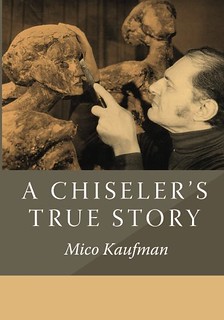 Collectors of Presidential Inaugural Medals will recognize the name Mico Kaufman. While one of America’s greatest living sculptors, he has
chosen an enigmatic name for his autobiography. While all of his more than 300 medals were modeled, he chose the title, “A Chiseler’s True
Story.”
Collectors of Presidential Inaugural Medals will recognize the name Mico Kaufman. While one of America’s greatest living sculptors, he has
chosen an enigmatic name for his autobiography. While all of his more than 300 medals were modeled, he chose the title, “A Chiseler’s True
Story.”
Chisel implies carving, typical method of creating sculpture. Mico is a master of both modeling and carving. At age 92 his life work reflects his mastery of four sculptural media – bronze, wood, pewter and polymer plastic – in a range of sizes from a 2-inch medal to an 18-foot monumental male figure.
His medallic work spans five decades, first under the commission of Medallic Art Company which produced the majority of his medallic work starting with the Gerald R. Ford Vice Presidential Inaugural Medal. Later models were for Franklin Mint, Art Medals Inc. and Longines Wittnauer.
As such, his most noted medals were the four Inaugural medals for three presidents: two for Ford (as VP and President), Reagan’s Second Inaugural and the George Bush Medal. His inaugural model of Jimmy Carter submitted to the Inaugural Committee by Medallic Art was outbid by Franklin Mint (by one million dollars) but Mico’s was considered by all a far more lifelike and superior portrait.
The author quotes medal dealer Joseph Levine at the beginning of his chapter, “Medallic Sculpture,” noting the artist’s major impact on presidential medals. He also reprints a favorable article by Numismatic Literary Guild exec Ed Reiter in this chapter. Of numismatic interest Mico created two coins for Marshall Islands, and two badges for American Numismatic Association Conventions, 1973 and 1976.
While his total medal count – by my website listing – is 309, he created the obverses of 192 medals of the 200-medal series, “History of America,” with reverses by MACO staff artist Ramon Gordils.
His Society of Medallists medal of 1973 bore a war-time theme. It was the first of nine medallic series – including United States Capitol Historical Society and four for Franklin Mint -- in which he prepared one or more issues.
His medallic talents were recognized by both ANA for their Sculptor of the Year Award in 1978 and the American Numismatic Society with their J. Sanford Saltus Award in 1992.
Mico Kaufman was born January 3, 1924 in Buzau, Romania. The first chapter of “A Chiseler’s True Story” recounts his early life in a way seldom encountered in biographical literature, in brief takes, he calls “fractured snapshots.”
Even so, the text reveals his Spartan youth, his leaving home at 17, a journey with bouts of illness and hunger – cured with sessions in several Kibbutzes -- until he ends up in Rome to study at the Academy of Fine Arts. Meanwhile he is attracted to a beautiful Greek girl he marries and bears their daughter.
While much of this takes place in 1947, it is not until 1951 that he immigrates to America, preceded by an uncle. Those four years are not covered in the book. In America he works at modeling toys for a Nashua toy company. The pay is so low his wife, now with three children, leaves him, unable to cope as an artist’s wife.
Mico does not mention this in his book, but one of his creations in this early period was Burgerboy, the colorful trademark for the Burger Boy chain of restaurants.
He was introduced to medals by William Louth, president of Medallic Art, on a trip to their Danbury plant. Louth recognized the potential talent in the artist seated in his office and gave him a chance to prepare a relief model for the Ford VP Medal.
 Mico’s design and model won over four other artist’s submitted designs. His model was placed in production and met with Ford’s approval. It
led to a second Ford Medal when Ford was named President and deserved his own Presidential Inaugural Medal.
Mico’s design and model won over four other artist’s submitted designs. His model was placed in production and met with Ford’s approval. It
led to a second Ford Medal when Ford was named President and deserved his own Presidential Inaugural Medal.
Mico met with Ford in person at the White House ceremony awarding the President his gold medal. With this success he was commissioned to create George Bush’s medal. This time he was allowed a 50-minute session to model the president from life.
Medallic commissions rained on the medallist, now considered a seasoned sculptor in bas-relief. Portraits, events, anniversaries, art medals, historical medals, all were gist for the artist’s nimble fingers and creative mind. He kept busy.
Mico and I served together on the Massachusetts American Bicentennial Medal contest. After winnowing down to three designs, the committee choose one. The artist’s name did not appear on the design. When the winner was identified, Mico exclaimed, “she’s my former student.”
Mico’s autobiography is the product of a very intelligent mind. The language, however, is not the soft-spoken Mico I know. The book covers his other sculpture as well: bronze casts, monumental works, miniature pewter figures, and more recently, polymer sculpture.
The book is uneven in its editing. Table of Contents lists the medallic sculpture chapter as “medallics.” There is no such word. The last chapter, “Musings” is disconnected, as if the author wanted to record in print his every thought. The book lacks an index and the customary list of the artist’s works with dates.
Even so it is an easy read and would appeal to any serious collector of Mico Kaufman medals offering rare insight to the artist and fascinating medallic lore to medals in their collection. Available in stiff card cover from Amazon for $55.
To read the complete article, see:
A Chiseler's True Story: The Art of Mico Kaufman
(www.amazon.com/Chiselers-True-Story-Mico-Kaufman/dp/1519571186/)

NEWMAN PORTAL SCANS COL. GREEN GOLD COINAGE PLATE BOOKS
 Through the generous cooperation of Dan Hamelberg, the Newman Portal has scanned two of the gold coinage plate books that document the Col.
E. H.R. Green collection. Prepared in extremely limited quantities by Stack’s in the 1940s, these photographic plates are the best record of a
collection that never appeared at public auction. The volume presenting the eagles consists of 22 plates, while the half eagles are depicted on 28
plates.
Through the generous cooperation of Dan Hamelberg, the Newman Portal has scanned two of the gold coinage plate books that document the Col.
E. H.R. Green collection. Prepared in extremely limited quantities by Stack’s in the 1940s, these photographic plates are the best record of a
collection that never appeared at public auction. The volume presenting the eagles consists of 22 plates, while the half eagles are depicted on 28
plates.
 Among the delicacies are the 1875 and 1933 eagles, while the half eagles include the 1815, 1829 large date, 1832 12-stars, and 1854-S
pieces. The 1822 half eagle (unique in private hands, then held by the Virgil Brand estate) is noticeably absent – even Col. Green didn’t get to own
everything. These two plate books were acquired by Hamelberg in George Kolbe’s sale of the Harry W. Bass, Jr. Library (part four) and previously were
handled by Abe Kosoff.
Among the delicacies are the 1875 and 1933 eagles, while the half eagles include the 1815, 1829 large date, 1832 12-stars, and 1854-S
pieces. The 1822 half eagle (unique in private hands, then held by the Virgil Brand estate) is noticeably absent – even Col. Green didn’t get to own
everything. These two plate books were acquired by Hamelberg in George Kolbe’s sale of the Harry W. Bass, Jr. Library (part four) and previously were
handled by Abe Kosoff.
To view the Col. Green gold coinage plate books on Internet Archive, see:
https://archive.org/details/newmannumismatic?and%5b%5d=Col.%20Green
BUILDING THE D. BRENT POGUE COLLECTION
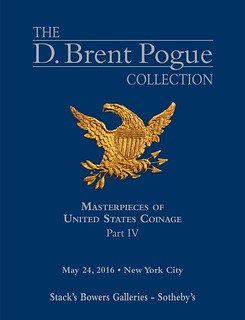 Just as history is always more intricate and intense as it is being lived than it seems in retrospect, assembling a collection like this
one is a more complex endeavor than a neatly organized auction catalog containing 63 superb coins may make it seem. While the coins acquired by D.
Brent Pogue and his father Mack fill this catalog, the fourth in a series, what’s not included perhaps defines the Pogue Collection as much as what
is included.
Just as history is always more intricate and intense as it is being lived than it seems in retrospect, assembling a collection like this
one is a more complex endeavor than a neatly organized auction catalog containing 63 superb coins may make it seem. While the coins acquired by D.
Brent Pogue and his father Mack fill this catalog, the fourth in a series, what’s not included perhaps defines the Pogue Collection as much as what
is included.
Nowhere on the pages to follow will there be evidence of the hundreds, perhaps thousands, of auction catalogs that were scanned and set aside after discovering they offered no coin important enough to add to this collection. The hours of phone conversations held with trusted advisors are unrecorded and unmentioned. Trips to dozens of coin shows across the United States, peering in cases and fielding offers from all comers, are not cited within, nor are the years of experience required to discern true gems from fool’s gold.
Much of this collection was formed before the era of certification, placing extra importance on the eyes and courage of the purchaser. The expertise and confidence needed to purchase coins in such an environment is implicit here, even as the results of those processes are evident to all.
This collection was formed one coin at a time. While a few small groups were acquired en bloc, including the Lawrence Stack Type Set and the Foxfire Collection, most were added as they revealed themselves singly to the marketplace. Such an endeavor requires both patience and quick reflexes, the former enabling a collector to wait for the right coin, the latter allowing them to pounce when it becomes available. The spaces in between acquisitions were full of study, consuming books and catalogs, listening more than speaking when experts were around, and studying far more coins than will ever bear the Pogue provenance.
Building a catalog is not entirely unlike forming a collection. For every research reference that is cited, several more proved useful, and dozens of further sources were examined despite yielding little. Experts in every specialty allowed ready access to their knowledge and libraries, typically on a deadline and with nothing in return but gratitude. The brute labor of numismatic research is not a profitable endeavor, but people like Saul Teichman, Craig Sholley, John Dannreuther, P. Scott Rubin, and others harvested facts with a sharpened scythe for years in expectation of no greater return but the joy of discovery and the pleasure of their work proving useful. It has, and to these gentlemen and others, who opened their notebooks, libraries, and memories, I am grateful beyond words.
Just as the work of coin buying became a little easier after the dawn of coin certification, so too has the work of numismatic research become less onerous in the age of digitization. Had the extraordinary riches of the Newman Numismatic Portal been available when the first three D. Brent Pogue catalogs were being written, they might each be a pound heavier. Only time limits the amount that can be discovered from the published works and unpublished archives made available by the NNP. Other institutions have also made these travails less trying, including the American Numismatic Society and the American Numismatic Association, whose searchable digital archive of The Numismatist makes membership one of the numismatic community’s greatest bargains.
As a participant in the creation of the Newman Numismatic Portal I'm glad to see confirmation of its great value for numismatic researchers, which only grows stronger with each additional book or document. -Editor
To read the complete article, see:
The D. Brent Pogue Collection, Part IV
(http://media.stacksbowers.com/poguecollection/pogue-coin-list_4.html)
THE BOOK BAZARRE
MORE ON THE MICHIGAN STAMP AND COIN COMPANY
Regarding Jeff Starck's question about the Michigan Stamp and Coin Company, Pete Smith writes:
The digital archive for The Numismatist includes several full page ads for the Michigan Stamp and Coin Company.
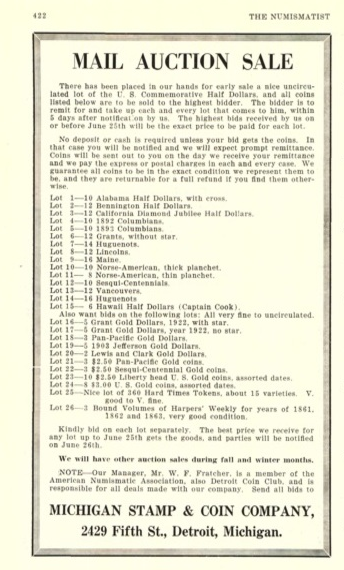
QUICK QUIZ: Pete Smith adds:
What important role did W. F. Fratcher play on the early history of the American Numismatic Association?
To see the ad in the original Numismatist, see:
www.exacteditions.com/read/thenumismatist/june-1930-43727/72/2
To read the earlier E-Sylum article, see:
NOTES FROM E-SYLUM READERS: APRIL 10, 2016 : Michigan Coin and Stamp Company
Information Sought (www.coinbooks.org/esylum_v19n15a13.html)
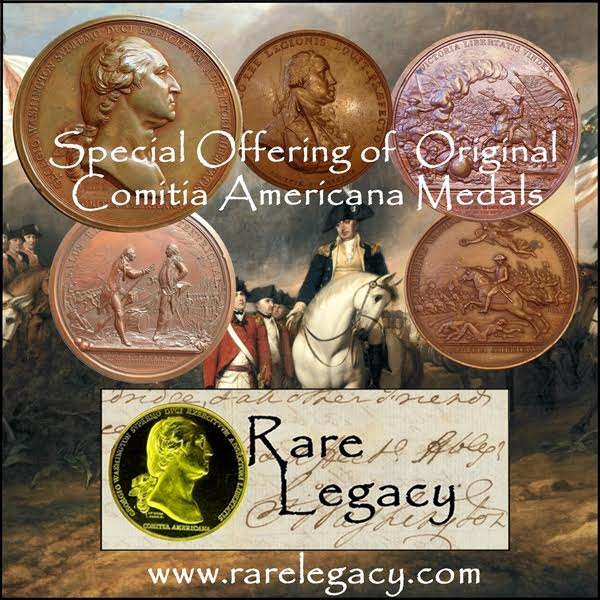
NOTES FROM E-SYLUM READERS: APRIL 17, 2016
Query: Was A Book Published With a Dust Jacket?
Christopher Buck writes:
I have a question for E-Sylum readers. Is there a way to determine if a coin book (or ANY book for that matter) was originally published with a dust jacket? This question has vexed me for some time.
More on Convict Love Tokens
Bob Lyall writes:
I see you have made mention of the love tokens for convicts being transported to Australia; the March/April issue of the TAMS Journal includes a detailed paper I wrote on a convict sent to Bermuda to build the naval dockyard. I would expect it to be the most comprehensive study of a convict and his family ever published.
To read the earlier E-Sylum article, see:
AUSTRALIA ISSUES “CONVICT LOVE TOKENS” COINS
(www.coinbooks.org/esylum_v19n15a36.html)
2014 Half Dollar Found Circulating
 Paul Williams of Reno, NV writes:
Paul Williams of Reno, NV writes:
I've been examining every half dollar that comes my way on the poker table. Today I received a 2014 clad half dollar.
To read the earlier E-Sylum articles, see:
NOTES FROM E-SYLUM READERS: MARCH 20, 2016 : Half Dollars Still Circulating in
Reno, NV (www.coinbooks.org/esylum_v19n12a12.html)
THE HALF-DOLLAR’S ACCIDENTAL DEMISE
(www.coinbooks.org/esylum_v19n11a15.html)
More on Lady Laverly
Regarding the 'Lady Laverly' banknote discussed last week, Gene Hessler writes:
 For those who might not know, Lady Lavery, Hazel Jenner, a painter, was from Chicago. In 1898, at 17, during a European trip Hazel met John
Lavery, a widower, and romance blossomed. Mrs. Jenner rushed her daughter away and pushed her into marriage with a Dr. Trudeau, who died within a few
years. Hazel Jenner returned to Europe in 1910 and married John Lavery who was knighted in 1918. Lady Lavery died in 1935 and Sir John Lavery died in
1941.
For those who might not know, Lady Lavery, Hazel Jenner, a painter, was from Chicago. In 1898, at 17, during a European trip Hazel met John
Lavery, a widower, and romance blossomed. Mrs. Jenner rushed her daughter away and pushed her into marriage with a Dr. Trudeau, who died within a few
years. Hazel Jenner returned to Europe in 1910 and married John Lavery who was knighted in 1918. Lady Lavery died in 1935 and Sir John Lavery died in
1941.
Sir John wrote the following of his wife: "She had a talent for drawing that was quite remarkable. She was very beautiful and possessed the largest and most heavenly eyes I had ever seen. She wandered about Ireland in a dream finding out that she was really Irish."
For the bank note portrait of his wife Lavery asked for 100 guineas, but received twice the amount. The engraver of this pensive portrait was master engraver John A.C. Harrison (1872-1955).
To read the earlier E-Sylum article, see:
THE “LADY LAVERY” IRISH FREE STATE £50 BANKNOTE
(www.coinbooks.org/esylum_v19n15a32.html)
More on Ben Green
Dave Hirt writes:
I enjoyed reading the post on Ben Green. I have collected his sale catalogs for a long time. One of his sales was the first ANA convention auction sale at the 1907 Columbus, Ohio convention. The1907 Oct-Nov issue of The Numismatist reports, "The real fun of the convention was Wednesday night. Dr. Ben Green's far famed auction sale came off, and all the latent hilarity pent up in the members burst forth to make this evening one grand time".
As was mentioned, Green was also one of the founders of the Chicago Numismatic Society. I believe that Green's outgoing personality was the glue that held that society together. After his sudden death in 1914, the society seemed to go slowly into decline. the last report of their meetings that I can find published in The Numismatist's, Meetings of Societies is in the June 1915 issue.
To read the earlier E-Sylum article, see:
BENJAMIN G. GREEN (1860-1914) (www.coinbooks.org/esylum_v19n15a16.html)
QUERY: SILVER PENNY REPORTED FOUND IN SHELL MIDDEN
Web site visitor Mal Carey writhes
Have any of your readers ever encountered a published account of a find of a Stephen I Silver Penny in the Damariscotta Whaleback Shell Midden? Figure 1 below shows the scope of the oyster shell heap. Natives harvested oysters along the Damariscotta River for perhaps 2000 years. A considerable number of archaeological artifacts were encountered by the Peabody Museum and the workers excavating the site for lime and "chicken scratch". The silver penny was supposedly found in the working face of the heap.

Archaeological evidence indicates that about 12,000 years ago, people began migrating into areas that had once been occupied by the last great ice sheets, including the region we know today as Maine. From the middle and late 1800's up to the present time, researchers have studied places where these people left evidence of how they lived. In the coastal region of Maine, shell middens, also known as shell heaps or mounds, are one of the more common types of sites that document methods of food-gathering. Two of these middens are by far the deepest such sites on the Atlantic coast north of St. John's River in Florida (Bourque and Weddle, 1995).
For more information, see:
The Damariscotta River Oyster Shell Middens
(www.maine.gov/dacf/mgs/explore/marine/sites/apr11.pdf)
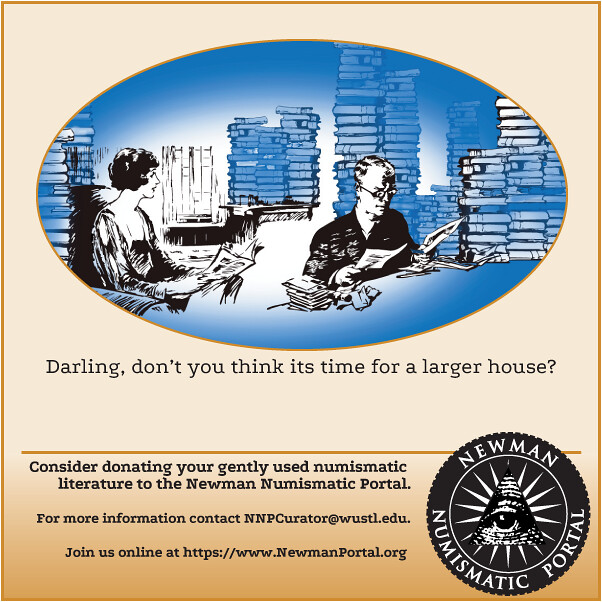
FORGERIES AND FAKES AT MOUNT VERNON
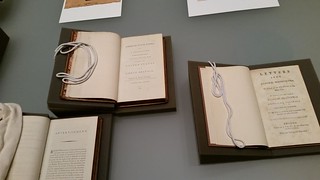 Mount Vernon’s new presidential library was one of 12 locations in the D.C. area and among 160 venues worldwide that participated in an
eclectic Obscura Day 2016 on April 16. The topic of this session was fraudulent and fake documents and artifacts of George Washington.
Mount Vernon’s new presidential library was one of 12 locations in the D.C. area and among 160 venues worldwide that participated in an
eclectic Obscura Day 2016 on April 16. The topic of this session was fraudulent and fake documents and artifacts of George Washington.
The sponsoring group, Atlas Obscura, which visits unusual history sites, attracted 25 people to the Fred W. Smith National Library for the Study of George Washington, which is adjacent to the historic mansion. Participants had an opportunity to view bookplates, books and papers which were concocted by three notorious forgers in the mid-nineteenth and early twentieth centuries.
The tour was led by Michele Lee, a special collections librarian who is personally interested in studying Washington fakes and forgeries, and supplemented by comments from Mark Santangelo, the chief librarian and archivist. Also present was Mary Thompson, a research historian. Santangelo and the library were profiled in The E-Sylum two years ago.
The forgers discussed were Robert Spring, who practiced his trade in Philadelphia, Canada and Baltimore in the 1860s and 1870s; Joseph Cosey, who manipulated documents of historic figures during the 1920s and 1930s; and Charles Weisberg, also a serial forger and whose work spanned the 1930s and 1940s.
These and other forgers relied on tracing original documents, sometimes using a brazier as a light box for assistance. They also developed modest skills at freehand copies of the signatures of Washington and others. Coffee grounds were used to age paper.
Over the years, Washington forgeries have been uncovered by analyzing the paper, which sometimes was foolishly woven rather than laid, which was the practice in the eighteenth century; slipping up on the some of the finer points of Washington’s distinctive signature; and by the status of the deteriorating iron residue used in the ink.
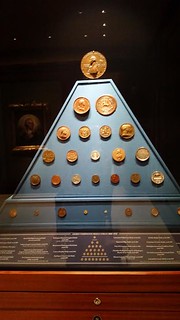 One of the unexpected treats of the visit was seeing two glass-enclosed pyramids of Washington medals, positioned immediately inside the
door of the rare book room. One group has 30 medals from 1778 to 1860 and the other 27 from 1860 to 1932. At the pinnacle of the latter assembly of
medals is the famous Saint-Gaudens inaugural centennial medal of 1889. Among other medals were Washington Before Boston medal and splashers and Laura
Gardin Fraser’s Washington bicentennial medal of 1932.
One of the unexpected treats of the visit was seeing two glass-enclosed pyramids of Washington medals, positioned immediately inside the
door of the rare book room. One group has 30 medals from 1778 to 1860 and the other 27 from 1860 to 1932. At the pinnacle of the latter assembly of
medals is the famous Saint-Gaudens inaugural centennial medal of 1889. Among other medals were Washington Before Boston medal and splashers and Laura
Gardin Fraser’s Washington bicentennial medal of 1932.
The tour was capped by an impressive, half-hour performance by a Mount Vernon historical interpreter who was portraying Robert Spring. The presentation was given for the first time.
For more information on Washington forgeries see this 2011 American Heritage article, cited on the tour: http://www.americanheritage.com/content/ignoble-profession. Charles Hamilton, the late noted autograph expert, also wrote two books on document forgers.
Atlas Obscura seeks out events to include on an ongoing basis. Perhaps numismatists have an interest in recommending or organizing events for them which highlight unusual aspects of the hobby. To make a recommendation, go to: http://www.atlasobscura.com/obscuraday2016. Scroll to the bottom.
To read the earlier E-Sylum article, see:
THE GEORGE WASHINGTON NATIONAL LIBRARY
(www.coinbooks.org/esylum_v17n19a16.html)
EDWARD DAVID COGAN (1803-1884)
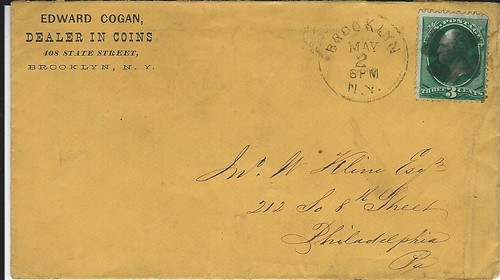
Cogan, Edward David (1803-1884), In 1866 he resided at 299 State Street, Brooklyn, New York; 408 State Street, Brooklyn, Kings County, New York; 68 William Street, Brooklyn, New York, later moved to 95 William Street, Brooklyn.
He was born on January 5, 1803 at Walthamstow, Essex County, England, son of Eliezer Cogan (1762-1855) and Mary Atchison (1769-1850). In 1851, he and his wife Louisa (1818-), and their five sons Richard, Thomas, Edwin, William and Charles and daughter Mary Louisa lived in Kent. According
His occupation in England was an accountant. In 1853, they moved from England to Camden, New Jersey... About that same year at Philadelphia he opened a curio shop as a dealer in fine art and books. According to his obituary in The Coin Collector’s Journal, May, 1884, he began in the coin trade in 1855 at his shop at 48 North 10th Street, Philadelphia, which is most probably an exaggeration.
On October 16, 1868, Edward Cogan became a Naturalized Citizen of the United States, Supreme Court of New York, Vol. 4, No. 457, witness by Peter Gilroy 614 Third Avenue, New York. It was when Cogan became a Naturalized Citizen of the United States he also became cantankerous.
There was controversy regarding the Randall catalog initiated by Ed Cogan who did not get to catalog John Colvin Randall’s second sale and might have felt that Ebenezer Locke Mason Jr. was muscling in on his turf taking away his client. These three men were all coin dealers. Apparently Cogan was furious that Mason was the one that Randall chose to deal with over him. In a rageful effort to prove to Randall and the entire collecting world his biased allegations that Mason was an inferior numismatist, inept cataloger, corrupt, money-hungry, dishonest coin dealer, Cogan began to publicly castigate and criticize him verbalizing these very allegations and false accusations either directly or by way of innuendo.
He retired on October 14, 1879 leaving the business to his sons George and Richard. According to the 1880 US Census he retired from the fur business.
At the time of his death April 17, 1884 the obituary in The Coin Collector’s Journal, May, 1884, mistakenly claimed “He was among the first to hold auction sales of coins in America, and it is stated on good authority that his catalogues, which unfortunately were unnumbered, are even yet greater in number than those of any other dealer.” Cogan has 70 coin auctions attributed to him over a span of 21 years from 1858 to 1879, whereas, John W. Haseltine, from 1870 up to April 1884 had 78 sales.
To read the complete article, see:
COGAN, EDWARD DAVID
(https://sites.google.com/a/numismaticmall.com/www/numismaticmall-com/cogan-edward-david?pli=1)
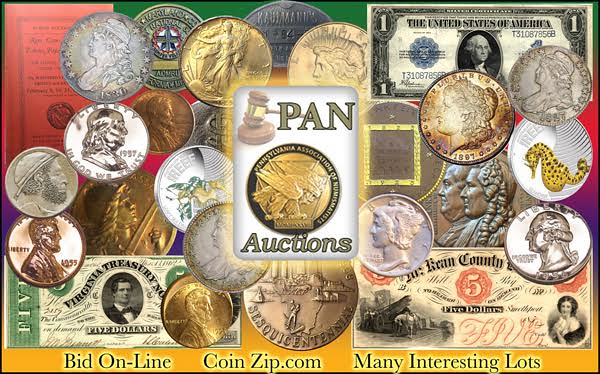
ARTICLE FEATURES COIN DESIGNER ANDREW LEWIS
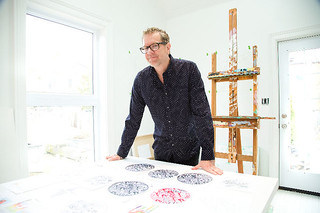 Andrew Lewis knows there’s two sides to the Canada goose.
Andrew Lewis knows there’s two sides to the Canada goose.
Somewhat fittingly, the London artist with an international reputation for creating posters chose the unpopular waterfowl as the subject of his design for a new silver coin issued by the Royal Canadian Mint.
“I love the look of them, but there’s a lot of them and they’re messy,” Lewis said.
He was asked by the mint in 2014 to come up with a design for a 2016 Canadian collector coin.
 Lewis spent more than 100 hours crafting a design featuring flying geese with an abstract series of patterns and shapes.
Lewis spent more than 100 hours crafting a design featuring flying geese with an abstract series of patterns and shapes.
He said his choice was inspired by his father, a pilot who loved anything that could fly.
The two-ounce coin with a raised surface is called Pop Art Canada Goose. It has a face value of $30 but sells for $169.99.
“I’m really happy with the final coin — a good design needs longevity,” Lewis said.
The coin was released in February. It can be purchased through the mint’s website or at authorized dealers, but only 3,000 pieces are available.
A graduate of Beal secondary school, Lewis recently moved back to London after living on the West Coast for 20 years. He has designed posters for London’s Grand Theatre, Scotiabank, Starbucks and Visa.
To read the complete article, see:
London artist’s design chosen
for mint’s new silver collector’s item (www.lfpress.com/2016/04/12/london-artists-design-chosen-for-mints-new-silver-collectors-item)
CONFERENCE: BELGIAN NUMISMATICS IN PERSPECTIVE
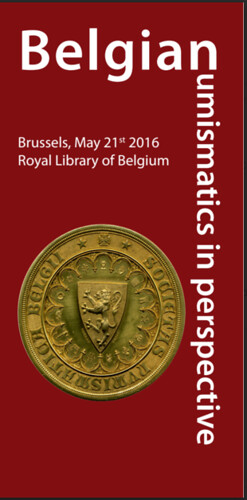
Founded in 1841, the Royal Numismatic Society of Belgium celebrates 175 years of its existence in 2016. To mark the event, a conference entitled “Belgian numismatics in perspective” will be held on Saturday, May 21st, 2016 in the Royal Library of Belgium (Brussels). Sketching the outlines of numismatic studies and their developments in Belgium from the 16th century till today, this conference will be concluded with an anniversary reception (only on registration).
Please register and pay your dinner fee by Friday, 6th May 2016 by bank transfer.
To visit the web site of the Royal Numismatic Society of Belgium, see:
http://www.numisbel.be/welkomgb.htm
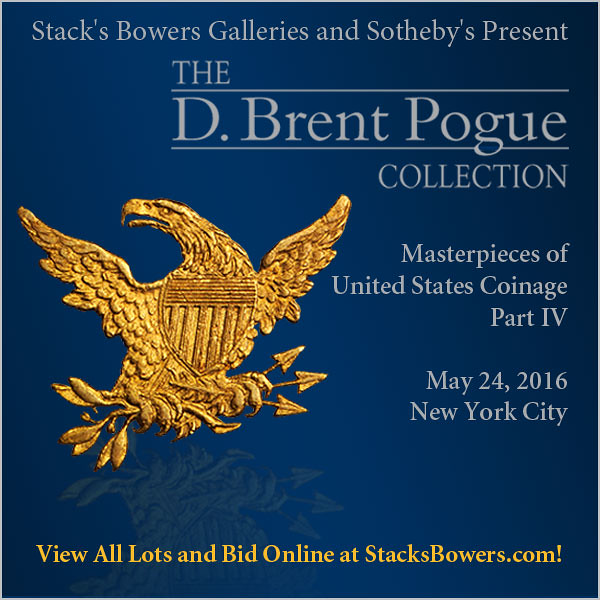
THE ROYAL MINT VISITOR EXPERIENCE
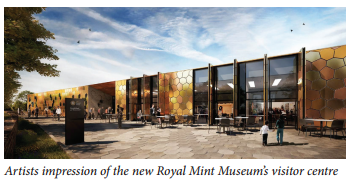
In displaying its collection, one of the challenges the Royal Mint Museum faces is that of location. There can be very few Accredited Museums which face the contradictory situation of engaging with the public whilst remaining located within one of the most secure sites in the United Kingdom. As a result, historically the best way to showcase the collection has been to work with other institutions, displaying objects through temporary and more permanent loans.
While this will remain an important part of the Museum’s future plans, the announcement made in April 2014 that a Visitor Centre was to be constructed on The Royal Mint site marked a new chapter for how the collection could be made publicly accessible.
Although tours of the Mint were commonplace at Tower Hill and after the move to South Wales, in recent times the site has been closed to the general public. The Visitor Centre, to be known as The Royal Mint Experience, will be the first time a designated venue will have been open to the public, providing an opportunity to visit the factory and explore an extensive interactive exhibition. The factory experience will no doubt prove popular with visitors as it will be the only place in the United Kingdom where coins for pockets and purses will be seen tumbling, freshly struck, from coining presses at the rate of over 700 a minute.
The exhibition area, which will allow items from the Museum’s collection to be displayed to the public, will form an important part of the Visitor Centre. Working with the design agency Mather & Co, The Royal Mint and the Museum have developed key exhibition messages, content and graphics to help bring the story of the Mint to life. The large area is split into six zones, each shedding light on a particular aspect of the Mint’s history and its current activities.
The Royal Mint Visitor Experience will also open up opportunities for the Museum to work with audiences who have previously not been able to access the site in any meaningful way. An education service will be provided through the Museum and over the last year a learning programme for primary school pupils in years three to six has been developed. When the Visitor Experience opens in the spring, school groups will be able to choose from two 90-minute workshops that link The Royal Mint’s past with the present day. Designed with specific learning outcomes in mind, one of these workshops will focus on the process of coin design, while the other will engage students with the scientific identification of fakes and forgeries through the ages.
For more information on the Money & Medals Network, see:
www.moneyandmedals.org.uk
LONDON GALLERY LETS STUDENTS HANDLE ANCIENT COINS
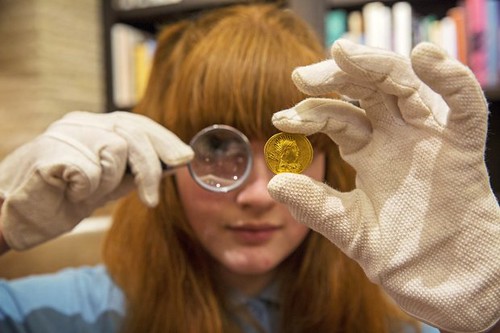
“Any idea how much this costs today?” a gallery assistant asks the teenage pupils as, gingerly, they put down a 3in-high bronze horse.
One girl suggests £1,000, another £10,000, a third £50,000. Each time, they’re told it’s higher. Hayley McCole, the assistant, shakes her head and replies: “It is now priced at £500,000.”
The school children stare down at the thin, graceful, slightly patinated votive, from Laconia, Greece, in the 8th century BC. One boy nudges another, saying: “More than a house.”
These artefacts, on sale at the Kallos Gallery, Mayfair, are being shown to children to encourage interest in Ancient Greece and other classical subjects in state schools. The 20 pupils have travelled from Patcham High School, Brighton. Moments earlier the teenagers took turns to handle the horse figurine: the only rules were to hold it over the table and cradle it in their palm, rather than pick it up by its slender, more delicate legs.
Next, Ms McCole produces three gold coins from ancient Greece, including a tiny piece found at Syracuse, Sicily, with the head of the nymph Arethusa on one side and Heracles killing the Nemean lion on the other. The children peer though magnifying glasses to absorb the exquisite detail, and ask how the coins were minted and stamped. Then comes the inevitable question: what are they worth?
Ms McCole, who like her audience is wearing white gloves, explains that coins derive value from their rarity, clarity and quality and far fewer survive from Ancient Greece than from Rome. The beauty of this coin gives it a value of £125,000.
To read the complete article, see:
Children hold a piece of
history (www.thetimes.co.uk/tto/education/article4733732.ece?shareToken=6a6962996b2975ba2bf7ed799e85e3ef)

UK MAN FINDS ROMAN VILLA BENEATH HIS HOUSE
 An "elaborate and extraordinarily well-preserved" Roman villa has been discovered by chance by a home owner laying electric
cables in his garden.
An "elaborate and extraordinarily well-preserved" Roman villa has been discovered by chance by a home owner laying electric
cables in his garden.
The villa was found after rug designer Luke Irwin unearthed a high-quality Roman mosaic at his Wiltshire farmhouse while laying cables so that his children could play table tennis in an old barn.
He called in archaeological experts and an eight-day dig by Historic England and Salisbury Museum revealed the home of a wealthy family living in luxury in what could be one of the largest such villas in the country.
The dig also turned up coins, brooches, bones of animals including a suckling pig, wild animals which had been hunted and a Roman well, while the experts identified a Roman child's coffin which had been holding geraniums by Mr Irwin's kitchen.
The villa - which is being compared to the Roman home at Chedworth, Gloucestershire, in size and wealth - was built sometime between 175 AD and 220 AD and was repeatedly remodelled up to the mid 4th century AD.
To read the complete article, see:
One of UK's largest ever Roman villas over 1,400
years old discovered by homeowner laying cables (www.mirror.co.uk/news/uk-news/one-uks-largest-ever-roman-7773926)
HORSES ON ANCIENT COINS
MORE THAN ANY OTHER ANIMAL (except perhaps the dog), the horse is beloved for its strength, intelligence, speed, loyalty and beauty. The earliest images of horses created by people appear on the walls of Chauvet Cave in France, dated to almost 30,000 years ago. People first domesticated horses for riding about seven thousand years ago on the Eurasian steppes. In the Greek epic the Iliad (first written down c. 750 BCE) the Trojan hero Hektor bears the epithet “tamer of horses” (hippodamoio).
A full-grown horse eats about five times as much as a man. Although a horse can eat grass (men generally cannot,) horses put out to pasture must spend much of the day grazing and digesting. Working horses require a high-quality diet of grain, and in the ancient world this made them costly to maintain. Only the wealthy could afford to keep horses, so they became symbols of aristocratic status and power.
It is not surprising that horses appeared on a wide variety of ancient coins.
Earliest Horses
The head of a horse wearing an elaborate bridle and bit appears at the very dawn of coinage on small, rare electrum (gold and silver alloy)
pieces from an uncertain mint of Ionia on the coast of the Aegean around 600 – 550 BCE. On such archaic coins, the front half of the horse,
or protome, was more common than the entire animal. We see this on a spectacular Ionian stater, possibly from Ephesos c. 575-560 BCE. In a
2013 European auction this rare piece sold for nearly $34,000.
A “prancing” horse appears on the obverse of the only type attributed to the last native Egyptian pharaoh, the gold stater of Nektanebo II (360-342 BCE, 30th Dynasty). These coins were issued to pay Greek mercenaries, who were accustomed to payment in gold. Only about 42 examples of this coin are recorded; the most recent to appear on the market sold for US$130,000 in the Triton XIX sale (5 January 2016, Lot 2075).

Horses and Riders
For king Philip II of Macedon, 356 BCE was a good year. One of his horses won a race at the Olympic games, and he commemorated this victory
on his coinage. In Greek, the name Philippos means “horse lover”
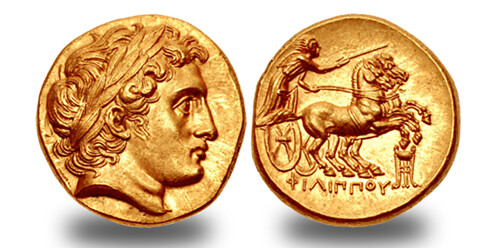
To read the complete article, see:
Horses on Ancient Coins
(www.coinweek.com/ancient-coins/coinweek-ancient-coin-series-horses-ancient-coins/)

AN EQUESTRIAN QUEEN ELIZABETH II ON COIN
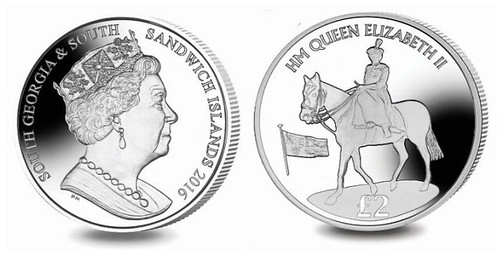
As the 90th birthday of Britain’s Queen Elizabeth II approaches, the British Overseas Territories of Ascension, British Antarctic Territory, British Virgin Islands, Falkland Islands, and South Georgia & South Sandwich Islands have launched a collection of crown coins to mark this milestone occasion.
This birthday is especially important as it is the first time that a reigning British monarch has reached the designation of a nonagenarian, or one who has reached their ninetieth birthday.
From the beginning of her young life, the young princess Elizabeth was immensely popular with the British public and with peoples all over the Empire. She won even greater respect and admiration when in 1947, on the occasion of her 21st birthday, she addressed the nation and Empire while on an official visit to South Africa with her parents, the King & Queen, making the following statement:
“I declare before you all that my whole life whether it be long or short shall be devoted to your service and the service of our great imperial family to which we all belong”.
From that time on, Princess Elizabeth, later Queen Elizabeth II, made good on her declaration. From the day of her accession to the British throne on February 6, 1952, the Queen’s life has indeed been devoted to the service of the British nation and what has evolved into the Commonwealth of Nations.
To read the complete article, see:
Falklands
launch collection of crown coins to honor the Queen's 90th birthday
(http://en.mercopress.com/2016/04/13/falklands-launch-collection-of-crown-coins-to-honor-the-queen-s-90th-birthday)
THE SIGNIFICANCE OF STAMPS USED ON BANK NOTES
As your collection grows in size it is not long before you run across a bank note or two with an adhesive stamp affixed to its surface. Since these notes are not too scarce - indeed some varieties are relatively common - every collector may expect sooner or later to acquire examples for his collection. Therefore, it may be of interest to explore the significance of these stamps.
Immediately our attention is drawn to the fact that stamp-notes came into issue for a variety of purposes. The most numerous of these notes are those which bear stamps indicating value. Perhaps the stamp bearing notes most widely known and collected today are those issued by Hungary in 1945. Three varieties of these notes exist: the 1,000 pengo with red stamp affixed, and 10,000 pengo notes with brown or blue stamps affixed to their obverse. These stamps were added to notes in circulation to increase their value. This move was made as an anti-inflation measure. The owners of the notes were required to pay ¾ of their value and in return received an appropriate stamp to signify this. As an economic move this measure was doomed to failure - the inflation running on to the astronomical ratio of one old pengo to 1,000,000,000,000,000 new ones! This costly experiment has left to the field of paper money collectors some of our most interesting specimens.
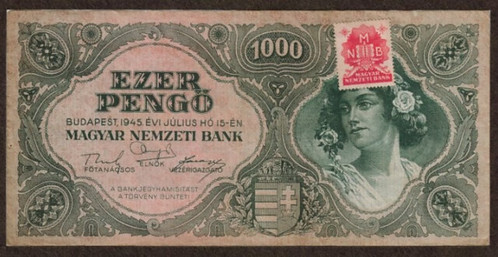
Almost equally well known are the stamp-notes used in Czechoslovakia after World War II. These notes are of two principal varieties and had their stamps affixed for entirely different reasons. The first of these notes were printed in Russia and were brought into the country for the use of the Russian Army. Records ascertaining the amount of these notes issued were improperly kept and it became necessary to count the notes to determine the quantity then circulating. To accomplish this, each note counted received a stamp. Those circulating without stamps continued to be counted while stamp-bearing notes were not counted again. Only notes in the denomination of 100, 500 and 1000 korun were counted.
We find on the 100 korun note a blue control stamp picturing the Czechoslovakian statesman Masaryk with a block letter “E” in its lower corners. The stamp itself is overprinted “100” in black ink. On the 500 korun note we find the same stamp with a red “500” overprint, and on the 1000 korun denomination the “1000” overprint is also in red. The other variety of stamp-notes used in Czechoslovakia were the former issues of Slovakia, counted and stamped for the same purpose. After World War II, Czechoslovakia, being recreated as it were, had no bank note issues of its own. As an emergency expedient the Russian occupation notes mentioned above and the notes of the former state of Slovakia were allowed to circulate side by side until they could be replaced with a post-war issue. When being counted, the Slovakian notes received their own stamps.
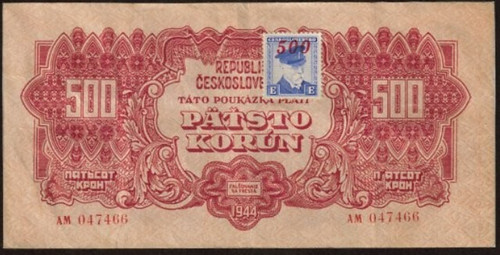
To read the complete article, see:
THE SIGNIFICANCE OF STAMPS USED ON
BANK NOTES (www.thecurrencycollector.com/pdfs/The_Significance_of
_Stamps_Used_on_Bank_Notes.pdf)
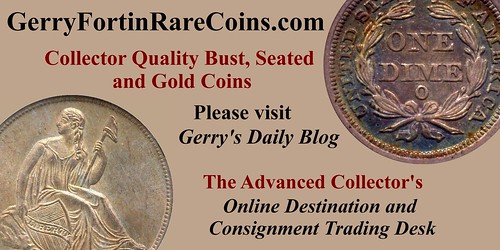
MILLION POUND BANKNOTE AUCTIONED BY SPINK
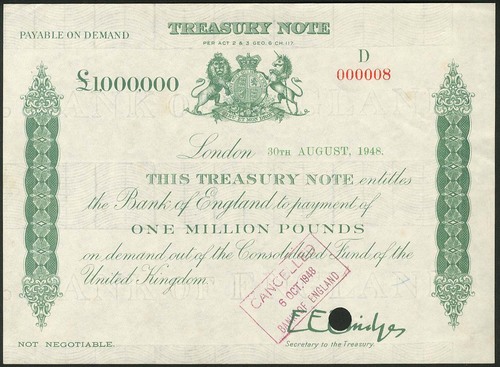
Treasury note, for £1,000,000, with text: 'entitles the Bank of England to payment of ONE MILLION POUNDS', London, 30 August 1948, red serial number D 000008, green text on white Bank of England watermarked paper, crowned arms top centre flanked by lion and unicorn, vertical green panel at left and right, PAYABLE ON DEMAND top right. Printed signature of E.E. Bridges low right. The note is hole cancelled over the signature and stamped 'Cancelled, 6 October 1948, Bank of England'.
Light folding otherwise extremely fine. Of the greatest rarity and the highest denomination note available to collectors. One of only two surviving examples, this one million pound note was issued in connection with the Marshall Aid plan after World War II and was intended for internal use as 'records of movements', the notes were in use for only a period of six weeks. It is believed that nine examples were produced, only two notes are believed extant, the other seven being destroyed.
The two surviving examples, numbers seven and eight were given as mementos to the respective U.S and U.K Treasury Secretaries. In the U.K's case this was E.E. Bridges. Number seven was first sold in 1977 and is listed in the Guinness Book of Records as being the highest denomination note in private hands. A magical denomination.
To read the complete lot description, see:
Auction: 16008 - British and World Banknotes Lot: 296
(www.spink.com/lot-description.aspx?id=16008000296)
To read the earlier E-Sylum article, see:
SPINK TO AUCTION MILLION POUND BANKNOTE
(www.coinbooks.org/esylum_v11n39a25.html)
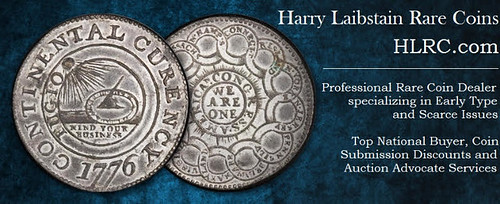
SELECTIONS FROM THE POGUE COLLECTION, PART IV
With some sadness, this catalog ends the presentation of the half dollars and half eagles of the D. Brent Pogue Collection. These denominations formed the heart and soul of the cabinet. The half eagles, in particular, are easy to access as the finest such grouping ever assembled. Before this catalog, there was only one living numismatist who had ever cataloged an 1822 half eagle. It’s humbling to become the second name on the list. The silver dollars herein, though few in number, pack perhaps the greatest punch, coin-for-coin, of any selection of the series ever offered.
The intricacy and intensity of the day-by-day production of this work would not have been possible without the synergistic help of Stacks Bowers Galleries employees in three different offices, as well as the aid of my wife and family here in South Carolina. Late night texts from California to confirm a provenance, mid-afternoon assurances that the home front was under control, and early morning access to the vault on 57th Street are contributions that will never be described in the pages of a catalog, but they were nonetheless vital and appreciated.
The Pogue Collection was formed to be enjoyed by others, but also because of an individual’s love of numismatics. This catalog was written the same way. I hope you enjoy it. For more information on the sale, please contact Christine Karstedt at ckarstedt@stacksbowers.com.
Lot 4001; Proof 1836 Reeded Edge Half Dollar


“I have the pleasure to send you herewith, and to beg you to exhibit to the President, the first specimens of our coinage of silver by steam, executed this afternoon.” — Mint Director Robert M. Patterson to Secretary of the Treasury Levi Woodbury, November 8, 1836
The introduction of steam power to the coining process represented the single greatest technological watershed in the history of the United States Mint. Though later changes to hydraulic and electric power made coinage successively faster and increased the Mint’s capacity, no other advance could match the change from mills powered by horses and presses powered by men to the neat mechanized efficiency of steam. When steam power was first connected to a press, United States coinage first became fully automated; when this coin was struck, the effort to mechanize the Mint was finally complete.
The first 1836 Reeded Edge half dollars were struck on Election Day, the second Tuesday of November 1836. Mint Director Robert M. Patterson was described in an 1854 biography by Samuel Breck as an adherent of “the Jeffersonian or Democratic school,” though moderate enough that no Whig tried to displace him from office. Given his political affiliation, Patterson probably visited the polls in Philadelphia and cast a vote for Martin Van Buren, the Democratic nominee, soon to be the President-elect. In the afternoon, Patterson sat down to write a letter to another Democrat, Levi Woodbury, who served as Secretary of the Treasury in Andrew Jackson’s administration and would remain in the position under President Van Buren. The letter enclosed the fruits of what must be counted as one of the most important days in the history of the United States Mint.
To read the complete lot description, see:
1836 Capped Bust Half Dollar. Graham Reiver-1
(https://auctions.stacksbowers.com/lots/view/3-4HYA0)
Lot 4007; 1838-O Capped Bust Half Dollar

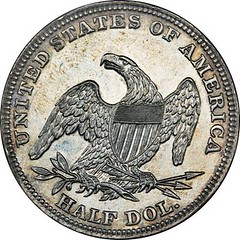
“They are not merely among the rarest Mint Marks, but the rarest pieces of United States coinage” — Augustus Heaton, A Treatise on the Coinage of the United States Branch Mints, 1893
There is a short list of American coins whose rarity and legend need no introduction. Among half dollars, there is only one of these signal rarities: the 1838-O. The story of its genesis coincides with that of the New Orleans Mint, the first branch mint to strike silver coinage. Just 20 are thought to have been struck, and only nine are known to have survived to the present day. Strictly judged on the merits of such a tiny population, this would be a famous and special issue, but its history and special production gives the 1838-O half dollar further layers of desirability.
Like all 1838-O half dollars, this coin was specially struck to accentuate its detail, coined with a finish to make it stand out among other half dollars of its type. Today, the 1838-O halves are called “Specimens,” a modern term to acknowledge their distinctive minting procedure and texture, though in the past they have often been called Branch Mint Proofs. The fields are reflective, displaying a handcrafted surface that is neither frosty like typical half dollars of this era struck for circulation, nor mirrored like Proof half dollars coined in Philadelphia for presentation or sale to collectors.
From this smooth surface, the devices stand out with exceptional boldness. Each star not only has central detail, its angles are taut and its points are sharp. The portrait of Liberty is presented in rounded, sculptural relief; her hair is engraved with the fineness of terracotta incised with a reed while still wet. The denticles are individually formed and stand apart from the rim.
The reverse shows every engraved contour of the eagle, from beak to talons, a textbook on how this design type would look if the engraver’s sketch became manifested into metallic reality.
The strike was so forceful as to create a wire rim, called a “fin” in the mint terminology of the era; seen as a striking imperfection by the coiners of that time, the fin was diminished before release, but is still somewhat visible around the reverse.
To read the complete lot description, see:
1838-O Capped Bust Half Dollar. Graham Reiver-1. Rarity-7
(https://auctions.stacksbowers.com/lots/view/3-4HYAX)
Lot 4012; “Proof” Garrett 1795 Draped Bust Dollar
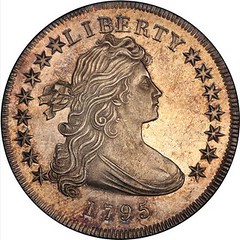
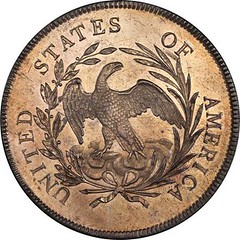
“This beautiful dollar, so far as condition is concerned, Mr. Randall declares is unique. I certainly have never seen one approaching it in perfection and beauty.” — W. Elliot Woodward, 1885
J. Colvin Randall’s eye for quality was renowned during his long association with numismatics. He flourished from the 1860s until the 1890s, but the June 1885 sale of his collection is the event for which he is most remembered today. Randall’s name had been on many catalog covers before, but the W. Elliot Woodward sale of his cabinet contained his choicest pieces. The sale is given John W. Adams’ highest rating, A+; he comments that Randall’s “complete regular mint series” was the “best ever for condition,” including a “Proof 1795 $1.” This coin was one of three early dollars in a row across the top of the photographic plate that opposed the catalog’s title page. Woodward’s preface made clear that while Randall had been a dealer for years, he had also been a collector who “made it a constant practice to reserve the finest and rarest pieces which have fallen into his hands during all this period, until his collection is now unrivaled in those specialties to which he has given particular attention, notably the gold coins and the larger coinage of silver.”
Describing his quality connoisseurship, Woodward wrote “Mr. Randall, however good a specimen he might possess, was never content if a better one existed until he became its possessor, and as a whole, the collection cannot be surpassed for fineness of quality. Collectors will not fail to notice such examples as the brilliant proof 1795 fillet head dollar.” The sale led off with his famous collection of silver dollars. This coin, selling as lot 12, brought $113, exactly $100 more than the Uncirculated 1795 Flowing Hair dollar in lot 11 and almost exactly double the $67 achieved by lot 1, a 1794 dollar described as “uncommonly fine.”
Randall’s greatest prize was acquired by T. Harrison Garrett, who was represented at the Randall sale by Harold P. Newlin. A week before the sale, on June 23, 1885, Newlin suggested a $200 bid on the 1795 dollar to Garrett. A few days after the sale, reporting on his successes, Newlin’s estimate increased: “The fillet head 1795 is worth $300.” The question was academic, as it wasn’t for sale. It would remain in the Garrett Collection for 95 years, until 1980.
To read the complete lot description, see:
1795 Draped Bust Silver Dollar. Bowers Borckardt-51, Bolender-14.
(https://auctions.stacksbowers.com/lots/view/3-4HYD2)
Lot 4026; 1822 Half Eagle
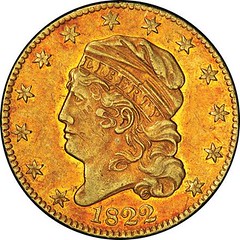
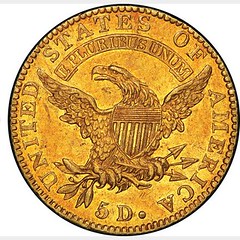
“I have the only one not in the hands of the government.” — Louis Eliasberg, on the 1822 half eagle, 1975
The turning point in the story of the 1822 may have been the 1890 Parmelee sale. Lorin Parmelee collected the greatest cabinet of United States and colonial coins ever assembled in 19th century America. Parmelee not only bought individual coins wherever he could find them, but he bought entire collections to get upgrades and issues he lacked. The collections he bought en bloc included some of the greatest numismatic cabinets of his era, like those of George A. Seavey, J. Carson Brevoort, and Charles I. Bushnell.
Seavey’s collection of gold coins was considered complete as early as 1864. When the time came for Parmelee to auction his holdings, he was undoubtedly horrified to find that his 1822 was a counterfeit. In order to maintain the integrity of the cabinet, Harlan Page Smith, a principal of the New York Coin and Stamp Company, inserted his own coin into the collection, though he had no intent to sell it. It was cataloged with a casualness that stood out amidst the spare prose of the rest of the Parmelee lots, called “awfully rare from way back” and correctly characterized as “the first and only one ever offered at public sale.” Smith bought the coin back for $900, and it remained his until his death in 1902.
By the time his collection was sold by the Chapman brothers in 1906, numismatists had finally grown aware of the date’s extraordinary rarity. Specialized numismatic auctions had, at that point, been commonplace for a half century, yet not one of them had ever included a genuine 1822 half eagle.
Smith was fond of telling the story of his coin’s discovery, plucked from a bullion dealer’s stock for $6.50. When it sold in the auction gallery of Davis and Harvey, Auctioneers, at 1112 Walnut Street in Philadelphia on May 8, 1906, it realized $2,165, a record. “1804 dollars must now take a back seat,” reported The Numismatist soon thereafter. “An 1822 half eagle at the Harlan P. Smith sale in Philadelphia brought $2,165.” The winning bidder, William Forrester Dunham of Chicago, already had an 1804 dollar, but his 1822 half eagle was his greatest prize.
To read the complete lot description, see:
1822 Capped Head Left Half Eagle. Bass Dannreuther-1.
(https://auctions.stacksbowers.com/lots/view/3-4HYH2)
To read the complete cataloguer's introduction, see:
The D. Brent Pogue Collection, Part IV
(http://media.stacksbowers.com/poguecollection/pogue-coin-list_4.html)

WAYNE'S NUMISMATIC DIARY: APRIL 17, 2016
 Tuesday April 12, 2016 was the regular meeting of my Northern Virginia numismatic social group, Nummis Nova. I arrived at the Da Domenico
restaurant in McLean around 6 pm. Eric Schena was already waiting in the parking lot, and we entered together and took our seats.
Tuesday April 12, 2016 was the regular meeting of my Northern Virginia numismatic social group, Nummis Nova. I arrived at the Da Domenico
restaurant in McLean around 6 pm. Eric Schena was already waiting in the parking lot, and we entered together and took our seats.
April 12th being the date in 1861 when the Civil War began (as Confederate troops fired on Fort Sumter in Charleston Harbor), I'd suggested a Civil War theme. I'd brought with me a binder of ephemera relating to Civil War numismatics and set it out for display on a spare table at the far end of our room.
I also brought along some souvenirs of the 2016 ANS Gala, a manuscript of Dick Johnson's Encyclopedia of Coin and Medal Technology,and for no particular reason, a copy of Hey Mister Horn Blower, the autobiography of numismatic author Gene Hessler.
In my view the blockbuster display of the evening was brought by Joe Esposito - fibers from the rope by which militant abolitionist John Brown was hanged, in Charles Town, Virginia on December 2, 1859.

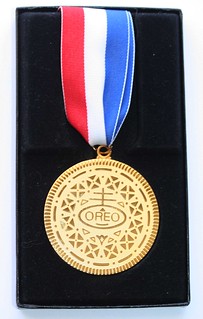 Our host for the evening was Joe Levine. Other attendees included Ron Abler, Julian Leidman, Steve Bishop, Jon Radel, Dave Schenkman, Wayne
Herndon, Howard Daniel and my guest Robert Hoppensteadt. Roger Burdette was there for a bit until a snotty waiter rubbed him the wrong way. We missed
him, but the rest of us stayed for the numismatic fellowship. The food wasn't bad, though it was overpriced and the waiters were indeed a unique
experience.
Our host for the evening was Joe Levine. Other attendees included Ron Abler, Julian Leidman, Steve Bishop, Jon Radel, Dave Schenkman, Wayne
Herndon, Howard Daniel and my guest Robert Hoppensteadt. Roger Burdette was there for a bit until a snotty waiter rubbed him the wrong way. We missed
him, but the rest of us stayed for the numismatic fellowship. The food wasn't bad, though it was overpriced and the waiters were indeed a unique
experience.
Gene tapped his glass to get everyone's attention, then made a show of presenting a gift to Julian. Mentioning the Oreo Cookies Julian kept in his shop for visitors, Gene delivered the 1988 Oreo Triathalon medal described in my January 2016 Diary. 5,000 of the 24kt gold plated medals were produced in a marketing promotion.
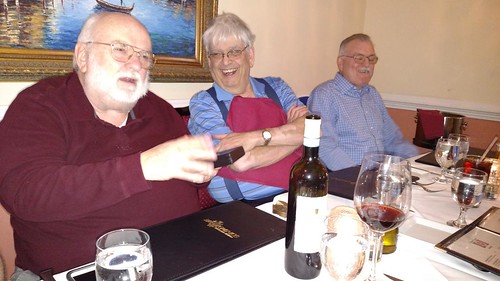
Gene Brandenburg, Julian Leidman, Howard Daniel
Topics at my section of the table included our recent dinner at the Whitman Baltimore coin show, planning for the kids event at the upcoming June Annandale, VA coin show, the Newman Numismatic Portal (and adding more numismatic material to it), and updating the Virginia Obsolete Paper Money books.
Numismatic exhibits were relatively thin this month, but included a couple nice ancient coins from Thrace brought by Robert, and some medals shown by Steve Bishop - see the next article for more details on those.
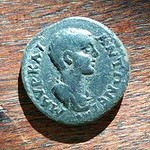
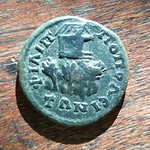
Robert Hoppensteadt writes:
This coin is from Philippopolis in Thrace. It is a 19mm bronze weighing 3.23 grams struck for the emperor Caracalla, with his young portrait on the obverse and what has been tentatively identified as the temple of Dionysus on the reverse set on a hill top with a grove of trees below. It was struck between 198 and 217 ad, probably on the early side based on the portrait
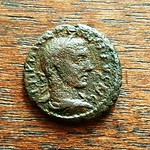
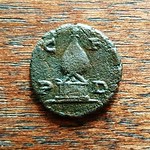
Robert adds:
This coin was struck in the Thracian town of Deultum, a town made up of retired and settled Roman legionairies. The coins, while struck in Greece, are interesting in that they have Latin inscriptions. The bronze coin, struck between 244 and 249, is very small, 16 mm and 2.76 grams. The obverse has a portrait of Philip I (also know as Philkip the Arab) and the reverse has some controversy. One group thinks the large object is an ancient beehive, another thinks it is a fountain, a replica of the Mons Sudans that was outside the Colosseum in Rome and another thinks it is a cult object related to the temple shown at the base. It is difficult to know, certainly the people who used these coins in their daily transactions in that city would have known exactly what it meant.
Dave Schenkman had this U.S. Mint produced medal for the June 1864 Great Central Fair in Philadelphia as well as an accompanying Season Ticket. The event was a fundraiser for wounded Union soldiers.

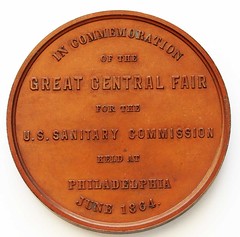
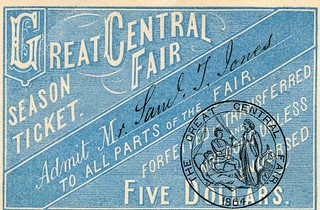
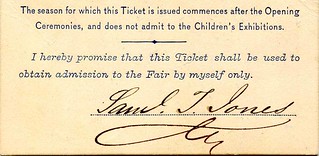
Dave writes:
The medal is a US Mint product (CM-44 in Julian). Four were struck in silver and 901 in bronze. The engraver was Anthony Paquet. Joe Levine commented that the card was probably a lot rarer than the medal.
Here are some photos Gene Brandenburg took at the dinner:
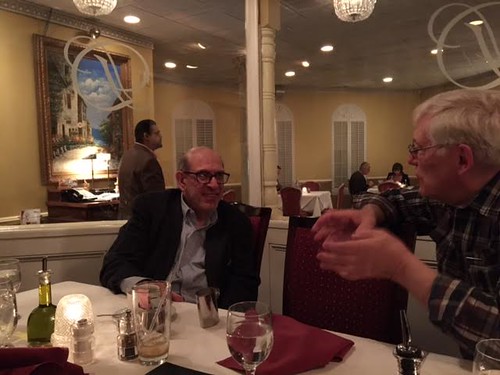
Joe Esposito and Dave Schenkman
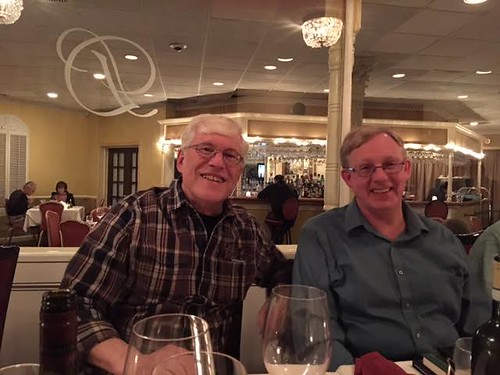
Dave Schenkman and Wayne Homren

Wayne Homren, Ron Abler, Robert Hoppensteadt
I hated to leave but eventually it was time. I still had a half-hour drive home and emails to catch up on. I packed up my display material and said my goodbyes. It was another great evening of numismatic camaraderie, but the non-numismatic world was ready to suck me back in. 'Til next month!
To read the earlier E-Sylum articles, see:
WAYNE’S NUMISMATIC DIARY: JANUARY 17, 2016 : The Oreo Triathalon Medal
(www.coinbooks.org/esylum_v19n03a24.html)
WAYNE'S NUMISMATIC DIARY: MARCH 31, 2016: PART 3 : Nummis Nova 2016 Baltimore
Dinner (www.coinbooks.org/esylum_v19n14a23.html)
THE BOOK BAZARRE
FINNISH MEDALS BY KAUKO RäSäNEN AND HEIKKI HAIVAOJA
I brought several Finnish Medals to the Nummis Nova dinner April 12, 2016. I got interested in these medals after Jon Radel brought some the previous month. He regrets that now, because now I compete with him for them on eBay.
Three were by Kauko Räsänen, probably the most well-known Finnish medalist. He won the American Numismatic Society’s J. Sanford Saltus Award for Outstanding Achievement in the Art of the Medal in 1986, and had a comprehensive retrospective exhibition at the State Coin Collection in Munich in 2010. The exhibition resulted in a comprehensive catalog of Rasanen’s work in 2011, Kauko Räsänen: Neue Wege in der Medaillenkunst (Kauko Räsänen: New Directions in Medallic Art).
The earliest Räsänen medal I have is one issued to the Finnish forestry products company Kymmene Aktiebolag in 1972. It depicts a gold mining pan with logs as the gold nuggets, symbolizing the financial significance of forest products in Finland.
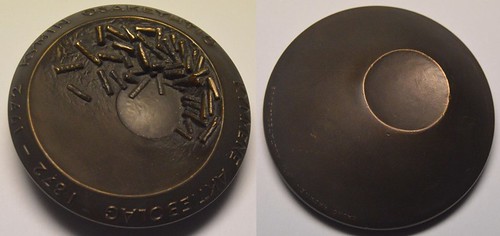
1972 Kymmene Aktiebolag Centennial Medal by Kauko Räsänen
Another medal by Räsänen was issued in 1981 to honor the Polish Solidarity leader who served as President of Poland from 1990 to 1995.
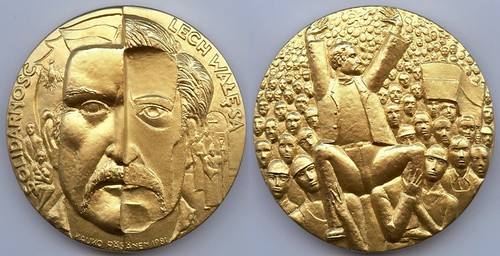
1981 Lech Walesa Medal by Kauko Räsänen
Finally, I had a two-part nesting medal issued for the 1972 UN Conference on the Human Environment. Räsänen became known for these multi-part medals, and produced some with three separate pieces all nesting snugly together.

Two Part 1972 UN Environmental Conference Medal by Kauko Räsänen
Two other Finnish medals were by Heikki Haivaoja, who also designed some coins issued by Finland. The first was issued in 1967 to honor the 50th anniversary of Finnish independence.
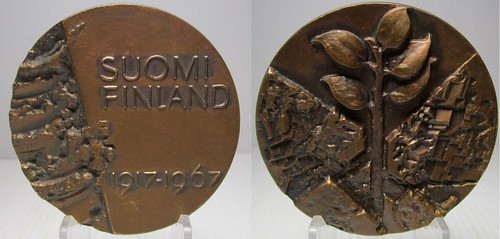
1967 Finland 50th Anniversary Medal by Heikki Haivaoja
The other medal by Haivaoja was issued to honor Rafael Paasio, the Finnish politician. Paasio served as the prime minister of Finland twice, from 1966-1968 and in 1972, and was also twice the Speaker of the Parliament. This medal is especially thick and heavy, and shows how a medal can really be an impressive piece of high-relief miniature sculpture.
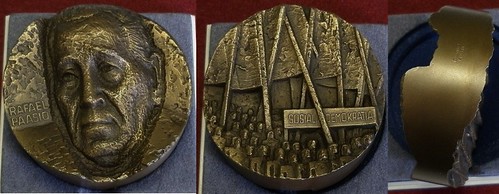
High-Relief Rafael Paasio Medal by Heikki Haivaoja
The last Finnish medal was designed by Toivo Jaatinen and was issued in 1982 for the 35th anniversary of the oil company Neste. It too is very thick and high-relief.
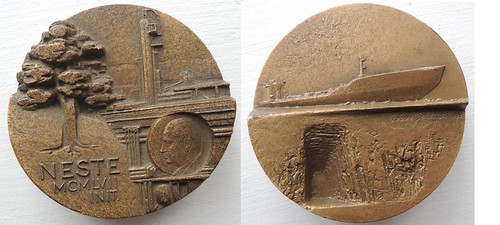
1982 Neste Oil Corporation 35th Anniversary Medal by Toivo Jaatinen
The final medal was an addition to my large collection of medals issued to honor Charles Lindbergh. Minted by the Paris Mint in 1977, it was designed by P. Peltier. I especially like how the reverse design depicts the curvature of the earth.
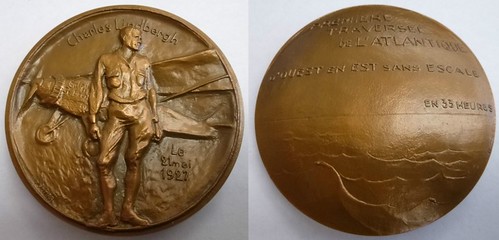
1977 Charles Lindbergh Medal by Peltier
To read the earlier E-Sylum article, see:
WAYNE'S NUMISMATIC DIARY: MARCH 13, 2016
(www.coinbooks.org/esylum_v19n11a16.html)

ARTICLE HIGHLIGHTS FIGHT FOR WOMEN ON U.S. BANKNOTES
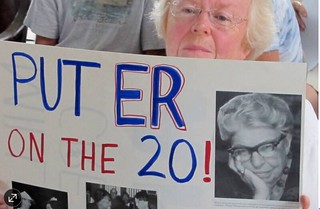 It began with the best of intentions: Put a woman on the front of America’s paper currency. It has since turned into something of a
nightmare for Treasury Secretary Jacob Lew.
It began with the best of intentions: Put a woman on the front of America’s paper currency. It has since turned into something of a
nightmare for Treasury Secretary Jacob Lew.
Women’s groups are voicing alarm that Hamilton-mania will succeed in pushing a woman off the front of the $10 bill to the back. Other signs hint at a far broader redesign in the works that would not only keep Alexander Hamilton on the front of the $10 note but that could also see Mr. Lew announce a woman on the front of the $20 note.
Mr. Lew announced last June a campaign to solicit public input on which woman to put on the front of the $10 bill. Currency officials had already planned a redesign that would issue the note with updated security features in 2020, coinciding with the anniversary of women’s suffrage.
Almost immediately, devotees of Hamilton—whose ranks have swelled after last summer’s Broadway debut of the blockbuster rap musical about the nation’s founding Treasury secretary—cast Mr. Lew as the second coming of Aaron Burr.
“I must admit I was appalled,” wrote former Federal Reserve Chairman Ben Bernanke, who echoed others’ calls to dislodge Andrew Jackson from the $20 bill. Mr. Jackson, the nation’s seventh president, led a successful campaign to kill off the nation’s central bank and stridently argued against the dangers of a paper currency.
Meantime, other groups that had petitioned the White House to put a woman on the $20 bill expressed disappointment that a woman would instead go on the $10 note, which is far less widely circulated.
“We told them this was not going to be popular. There were so many levels on which it didn’t make sense,” said Susan Ades Stone, executive director of the Women on 20s campaign, which began petitioning the White House last year. It conducted an online poll that said Harriet Tubman should go on the $20 note.
The criticisms caught Mr. Lew off guard. The Treasury Department explained that the government’s currency-security apparatus had already embarked on the redesign of several bills to include tactile features for the blind and visually impaired. For security reasons, officials concluded in 2013 that the $10 bill should go first, making it the best vehicle to ensure a woman would arrive on the currency in the near future.
Signs of Mr. Lew’s backtracking emerged following a series of public forums to solicit feedback last year. In December, the Treasury Department announced the decision would be delayed until 2016.
In recent interviews, Mr. Lew has said new plans extend beyond the $10 bill. He has said Hamilton—who was killed in a duel with Burr—will remain on the currency, and he has stopped saying a woman would go on the front of the $10 note.
“We’re not talking just about one bill. We’re talking about the $5, the $10 and the $20,” Mr. Lew said in an interview on CNBC on Thursday. “We’re not just talking about one picture on one bill.”
To read the complete article, see:
Musical
Chairs for Currency: Broadway’s ‘Hamilton’ Scrambles Plan for Woman on $10
(www.wsj.com/articles/musical-chairs-for-currency-broadways-hamilton-scrambles-plan-for-woman-on-10-1460658988)
When Professor Cheryl Greenberg sat down with leaders from the Treasury Department last August to talk about the future of the $10 bill, she and nearly a dozen historians from across the country wondered why the Treasury Department was not starting with another note.
“We came in saying, ‘Can we start with the 20?'” Greenberg, a History professor at Trinity College, recalled in a recent conversation with TIME.
The answer, quite frankly, is security. Though the Treasury Secretary ultimately signs off on the currency design, the Advanced Counterfeit Deterrence Steering Committee, or ACD, comprised of leaders from Treasury, the Secret Service and the Federal Reserve recommends notes for redesign. That decision is made with thwarting counterfeiting as the primary goal.
When the ACD recommended a change to the $10 bill, it was the denomination in which the rate per million— the number of counterfeit notes in circulation as reported by the Secret Service—was getting to a level that called for new technology. And because the $10 bill came first, the Treasury Department also saw the bill as its first opportunity to get a woman featured on U.S. currency, something Secretary Jack Lew has said is long overdue. Over the summer, the Secretary asked for public input on the selection process.
What TIME’s reporting and a slew of statements by the Treasury Secretary call into question, though, is whether or not the woman featured on the $10 bill will appear as the portrait. Treasury Department officials told TIME that the Secretary’s thinking has changed since the announcement in 2015, but did not specifically say how.
To read the complete article, see:
Why They Can’t Just Put A Woman on the
$20 (http://time.com/4292794/alexander-hamilton-andrew-jackson-20-10-bill-currency-woman/)
THE BOOK BAZARRE
NEW AUSTRALIAN BANKNOTE DRAWS CRITICISM
 The design of the new Australian $5 note is causing a major upset Down Under, and not just because it is considered by many to be “the most
hideous banknote in history,” but also because it has replaced the image of a celebrated women’s rights campaigner and all-round high achiever.
The design of the new Australian $5 note is causing a major upset Down Under, and not just because it is considered by many to be “the most
hideous banknote in history,” but also because it has replaced the image of a celebrated women’s rights campaigner and all-round high achiever.
The portrait of Catherine Helen Spence — “the first Australian woman novelist to write about Australian issues, the mother of the Australian foster care system, the leading campaigner for proportional representation in government, a hero of the women’s suffrage movement, and Australia’s first female political candidate, according to author David Hunt — was replaced by an image of the nation’s Parliament House; “a lump of neo-brutalist architecture.”
To read the complete article, see:
New banknote replaces celebrated suffragist with “lump of neo-brutalist architecture”
(http://nytlive.nytimes.com/womenintheworld/2016/04/13/new-australian-banknote-replaces-portrait-of-celebrated-suffragist-with-lump-of-neo-brutalist-architecture/)

In 1988, Australia celebrated its bicentenary by revolutionising banknote design, issuing the world's first polymer note, the brainchild of Australia's CSIRO. The organisation was so good at the science of making money that this is now the only science the Australian government will let it do.
And now, with the new $5 note, Australia is again leading the world in banknote design. The Reserve Bank is proud to announce it has designed, possibly, the most hideous banknote in history.
This is the start of a campaign to make our currency so nauseatingly unappealing that people will switch to electronic payments (saving the Australian government printing costs). The new wattle motif, designed to look like anthrax spores, will stop old people sending money by mail (saving the Australian government postage costs). The government must have retained the designer of Australia's 1984 Olympic uniforms to come up with a startling combination of off-pink and bilious yellow, before giving the Reserve Bank's gibbon the keys to the inkjet. Blind people will love the new banknote for its revolutionary tactile features, but mainly because they won't be able to see it.
The worst thing about the new $5 note, however, is that it dispenses with one of the greatest Australians ever, Catherine Helen Spence – who was commemorated in 2001 for the note issued to celebrate the centenary of federation.
Spence was the first Australian woman novelist to write about Australian issues, the mother of the Australian foster care system, the leading campaigner for proportional representation in government, a hero of the women's suffrage movement, and Australia's first female political candidate. And those are but a few of her achievements.
Spence has been forced to make way for a lump of neo-brutalist architecture – our Parliament House –topped by a giant Australian flag. A non-Australian, the Queen retains pride of place on the new note.
It's as if the Reserve Bank's new work experience kid, hired because he knows how to use Photoshop, has touched Liz up a bit, but not nearly as badly as Paul Keating did. She's got the same pearl necklace, but there's some grey in the roots and she looks a little more lived in. Of course, she looks nothing like the 89-year-old woman she is, as reality would present the wrong image of Australia to the world.
To read the complete article, see:
Australia's new $5
note keeps the Queen but drops women
(www.smh.com.au/comment/australias-new-5-note-keeps-the-queen-but-drops-women-20160413-go5481.html)
It may be the smallest denominated Australian dollar banknote, but a new design for the Australian $5 bill has attracted an outsized amount of criticism, with detractors calling it “hideous” and “like vomit”.
The note, which will replace its more bland predecessor from Sept 1, features a yellow Prickly Moses wattle flower and a colourful Eastern Spinebill native bird.
But critics, from social media users to bird lovers, were quick to express their disdain.
“Our new fivers look like vomit,” one Twitter user wrote, while another quipped: “A thousand monkeys with a thousand versions of Photoshop could never come up with something as hideous as the new Australian $5 note.”
The bill has even managed to raise the ire of bird lovers.
“It’s way off in terms of colouration,” Birdlife Australia’s migratory shorebird programme manager Dan Weller said, although the bird’s shape and markings were fairly accurate.
To read the complete article, see:
‘Vomit-like’ banknote
draws ire of Aussies and bird lovers
(www.thestar.com.my/news/regional/2016/04/13/vomitlike-banknote-draws-ire-of-aussies-and-bird-lovers/)

GOLINO ON MODERN U.S. COIN DESIGN
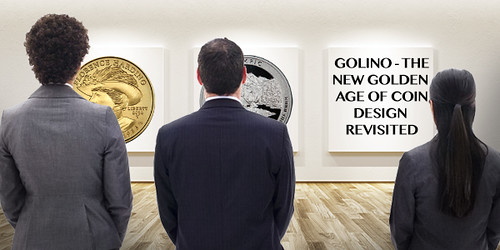
Perhaps few topics are more central to numismatics than the designs that appear on the coins we collect. Some people like to study mintage levels, the physical characteristics of coins and other issues, but at the end of the day it is really all, or at least mostly, about the art, as I have argued many times in this column.
Coin designs are especially important when it comes to postmodern U.S. coins because most collectors and numismatists believe something is fundamentally lacking in most of the designs that have appeared on U.S. coins since 1965, when copper-nickel replaced the silver in our coinage.
Back in 2012 I wrote about the effort of Edmund Moy (and really also John Mercanti, who served as Chief Sculptor-Engraver at the U.S. Mint from 2006 to 2011 though he was never confirmed by the U.S. Senate) to promote a “new golden age” in U.S. coin design.
That effort was ultimately successful (if only moderately), but nonetheless failed to have a lasting impact for two reasons.
First, in the years after Moy and Mercanti’s departure, there has been no real sustained effort by the Mint’s leadership to promote true excellence in coin design–though there has been some progress, which mostly comes from other actors, as I will explain.
Second, the so-called new golden age was less than fully successful because its major achievements–especially the 2009 Ultra High Relief gold double eagle—were based on reusing the classic designs of our past and failed to develop new designs that are of comparable artistic quality to the old designs.
The efforts of Moy and Mercanti include the introduction of many of the ongoing numismatic coin series that continue to this day such as the American Buffalo Gold coin series, which celebrates its 10th anniversary this year. In fact, the failure to do anything special in terms of design or finish for the 2016 Gold Buffalo is emblematic of the problem with U.S. coin design today.
As Citizens Coinage Advisory Committee (CCAC) member Donald Scarinci succinctly noted at the March meeting of this group, “Saint-Gaudens and Weinman are dead – get over it.”
So what’s happened since 2012?
There have certainly been a number of solid designs, even among the commemoratives, such as the 2016 National Park Service centennial $5 gold coin designed by the Mint’s current lead sculptor-engraver, Don Everhart – or the designs of the 2015 three-coin series for the 225th anniversary of the U.S. Marshals Service.
In addition, the American Platinum Eagle proof coins with changing reverse designs, which includes the half-ounce coins issued from 1998 to 2008 and the one-ounce coins issued from 1998 to present, are graced with some of the best recent designs, especially those prepared by Joel Iskowitz of the Mint’s Artistic Infusion Program, which seeks to encourage outside artists to design coins for the Mint.
But for every coin with a great design issued in the past few years, there are far more that are mediocre at best.
The CCAC has been working to promote the goal of better coin designs in part through its proposal for an American Liberty high relief gold coin and silver medal series that began in 2015. Central to this effort is the idea of representing the the ethnic and racial diversity of 21st century America.
But every time an image of Liberty that’s not based on Greco-Roman artistic convention is recommended by the CCAC and the Commission of Fine Arts (CFA), these groups encounter a barrage of criticism from collectors, who see the use of non-Caucasian Lady Liberties as being inspired by political correctness, or at a minimum as being artistically uninspired (if not simply unappealing).
It is certainly understandable that some people simply do not find the designs proposed appealing, like, for example, the proposed design for the 2017 issue in this series, but what’s troubling is the fact that so many collectors believe it is fundamentally wrong to depict Liberty in any other way than the way she has appeared in the past.
That view makes it especially difficult to create modern coins that use the allegorical depiction of Liberty as a representation of American ideals.
All collectors of U.S. coins appreciate the great Liberty designs of the past, but our coinage should reflect not only timeless ideals but also the ways in which the country has changed. Otherwise, our coinage will continue to appear static.
To read the complete article, see:
The Coin
Analyst – The New “Golden Age” of Modern U.S. Coin Design Revisited: The More Things Change, the More They Stay the Same?
(www.coinweek.com/recent-articles-video/coin-analyst-new-golden-age-modern-u-s-coin-design-revisited-things-change-stay/)
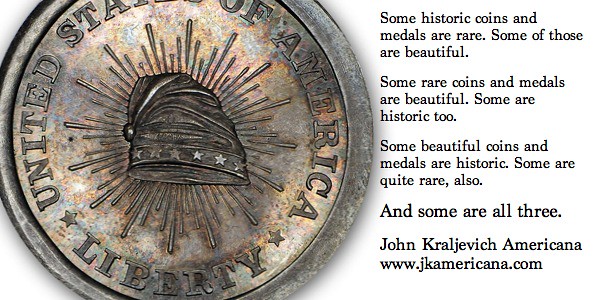
THE CUMBERLAND GAP QUARTER LAUNCH EVENT
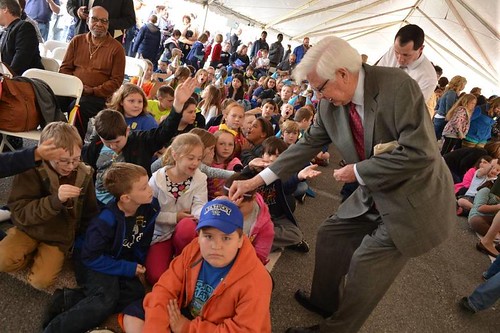
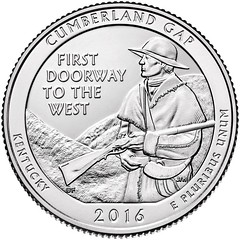 The U.S. Mint has released a quarter featuring Cumberland Gap National Historical Park.
The U.S. Mint has released a quarter featuring Cumberland Gap National Historical Park.
Representatives of the mint, National Park Service employees and U.S. Rep. Hal Rogers unveiled the quarter Monday at the park’s visitor center in Middlesboro. The event was attended by more than 2,200 schoolchildren from Kentucky, Tennessee and Virginia.
The coin, which depicts a frontiersman looking westward against a backdrop of mountains on the tails side, is the 32nd coin in the America the Beautiful Quarters Program. It includes the words “Cumberland Gap” and “First Doorway to the West.”
“Modern day explorers and travelers stand in awe at this great break in the Appalachian mountain chain, which gave passage to thousands seeking something new beyond the horizon,” Marc Landry, plant manager of the U.S. Mint at Philadelphia, said in a news release. “Millions of Americans will now have a reminder of the important role this mountain pass has played in the settlement of our nation.”
 The America the Beautiful quarters, which will feature 56 national parks and other sites, are being issued over a 12-year period in the
order in which the national sites were officially established. Five new quarters are released each year.
The America the Beautiful quarters, which will feature 56 national parks and other sites, are being issued over a 12-year period in the
order in which the national sites were officially established. Five new quarters are released each year.
Rogers, R-Somerset, said he hoped the coin would help increase awareness about the area and its history.
“It is my hope that folks will want to learn more about Daniel Boone and the early pioneers’ journey along the Wilderness Trail and through (the) original gateway to the west,” he said in a news release. “We want them to read about and visit this wonderful place that we call home.”
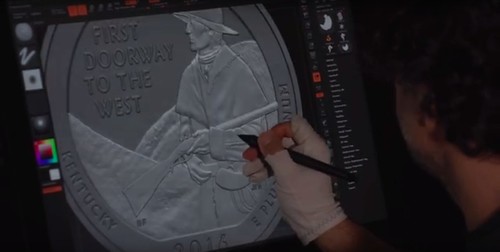
To read the complete article, see:
Cumberland Gap is featured on a quarter
(www.kentucky.com/news/state/article71247072.html)
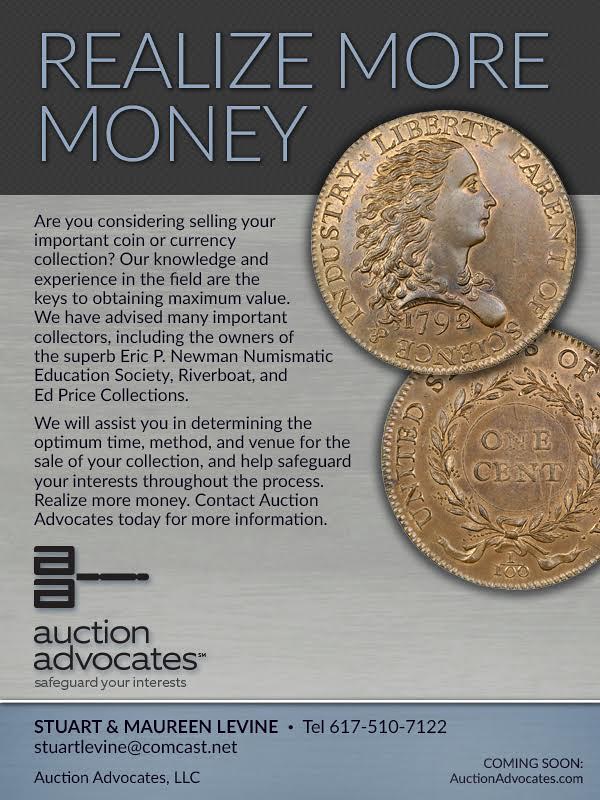
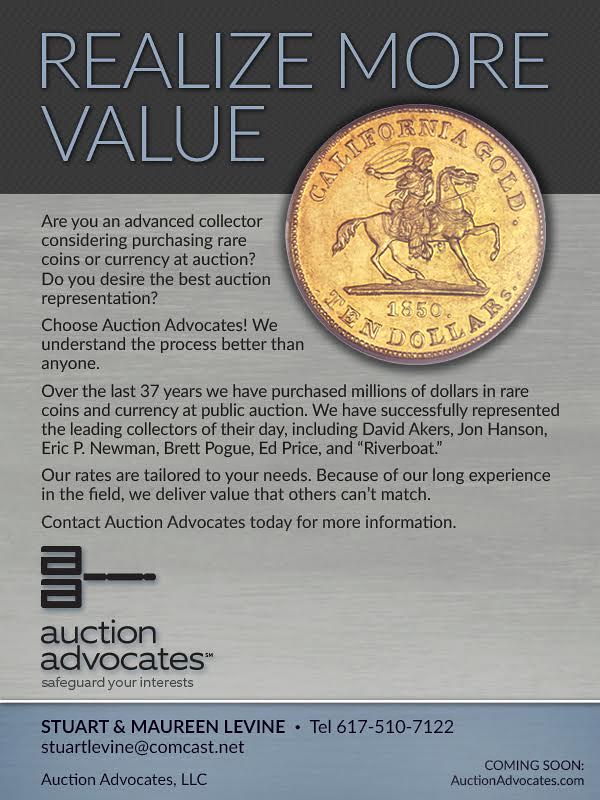
STOLEN INVERTED JENNY STAMP REAPPEARS
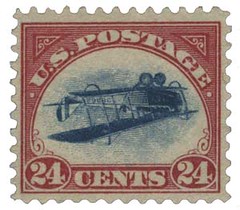 One of the longest mysteries in the stamp-collecting world is getting a new chapter.
One of the longest mysteries in the stamp-collecting world is getting a new chapter.
Six decades after four of the U.S. Postal Service's most celebrated misprints were brashly stolen from a collectors' convention, one of the missing "inverted Jenny" stamps surfaced this month at a New York auction house. The 1918 stamps, featuring an airplane printed upside-down, are among the world's most famous pieces of postage.
"It's one of the most notorious crimes in philatelic history, and there's a piece of the puzzle now that's in place," said Scott English, the administrator of the American Philatelic Research Library, which owns the stamp.
It was submitted to auctioneer Spink USA by a man from the United Kingdom who had inherited it from his grandfather and said he didn't know much about it, said George Eveleth, head of the Spink USA philatelic department. Authenticators determined it was not only a genuine Jenny - one of only 100 ever sold - but also one of the four from the 1955 heist.
The philatelic library is now working with Spink USA and federal authorities to reclaim the stamp. The FBI didn't immediately respond to a request for comment.
Eveleth said authorities had told the auctioneers not to release the name of the consigner, who is in his 20s, and it's unclear whether he has an attorney who could comment on the developments.
There has been no sign of any of the four stolen Jenny stamps in over 30 years, since two others were recovered in the 1980s and '70s. The whereabouts of the fourth are still unknown.
While it's unclear whether the would-be consigner can shed any light on the long-cold trail to the thieves, the stamp was accompanied by an intriguing item: a 1965 letter about a monetary loan from a noted stamp dealer to a well-known auctioneer, both now dead, Eveleth said. The letter isn't necessarily connected to this stamp, however.
Still, the Bellefonte, Pennsylvania-based philatelic library hopes the stamp's discovery could lead to new clues.
"We're going to remain optimistic," English said. "Because think about it: Here we are, 61 years later, and a stamp has appeared."
Worth 24 cents when issued, inverted Jenny stamps fetch hundreds of thousands of dollars today. While other stamps are rarer, the Jenny is one of few that is readily recognized even by non-collectors, Eveleth said.
To celebrate the launch of U.S. air mail, the Postal Service designed a stamp featuring a Curtiss JN-4H "Jenny" biplane. Some were printed with the plane inverted, and a savvy customer bought a 100-stamp sheet before anyone realized the error.
Over the years, they were separated, coveted, counterfeited, stolen on more than one occasion and narrowly saved from the blitzkrieg of London in World War II and from a flood in Wilkes-Barre, Pennsylvania.
Ethel B. Stewart McCoy, a New York heiress and stamp enthusiast, lent her block of four Jenny stamps to the American Philatelic Society - a separate organization that shares some ties with the American Philatelic Research Library - to exhibit at a 1955 convention in Norfolk, Virginia, where the stamps were stolen from a display case.
Two were recovered in the '70s and '80s from different Chicago stamp connoisseurs, who said they'd bought the stamps from people who had since died or whose names they didn't know, according to a 2014 article in American Philatelist, the society's journal. Those stamps went to the philatelic library, as McCoy had given it rights to all her stolen Jenny stamps before her 1980 death.
To read the complete article, see:
Stolen in 1955, famous "inverted
Jenny" stamp resurfaces (www.cbsnews.com/news/stolen-in-1955-famous-inverted-jenny-stamp-resurfaces/)
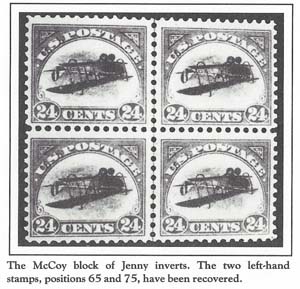 After careful expert examination the rarity was determined to be position 76 in the pane of 100 subjects. This position is the bottom right
stamp from the famous McCoy block of four, which was stolen out of its exhibition frame in 1955 during the American Philatelic Society convention in
Norfolk, Virginia. Ethel McCoy had purchased the block, from positions 65-66, 75-76, in 1936 from stamp dealer Spencer Anderson for $16,000 and it
was her most prized possession.
After careful expert examination the rarity was determined to be position 76 in the pane of 100 subjects. This position is the bottom right
stamp from the famous McCoy block of four, which was stolen out of its exhibition frame in 1955 during the American Philatelic Society convention in
Norfolk, Virginia. Ethel McCoy had purchased the block, from positions 65-66, 75-76, in 1936 from stamp dealer Spencer Anderson for $16,000 and it
was her most prized possession.
After the theft, the block was broken into four singles, and each copy was altered to disguise its appearance. Position 76 recovered by Spink had been reperforated at right and most of the gum was removed, so the pencil position numbers written on the gummed side had been lost, making identification a challenge.
1979 Ms. McCoy assigned all her rights to the block to the American Philatelic Research Library at the American Philatelic Society. Position 75, the top left stamp, turned up in 1958 at a Chicago stamp and coin dealer's shop and position 65, the bottom left stamp, was recovered in 1982.
To read the complete article, see:
SPINK U.S.A.
RECOVERS LONG-LOST 24c INVERTED JENNY
(https://www.spink.com/press-releases/spink-usa-recovers-long-lost-24c-inverted-jenny.aspx/?id=stamps&year=2016)
BALTIMORE GROUP PLANS NEW LOCAL CURRENCY ISSUE
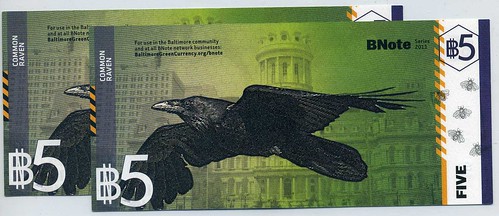
In the Spring of 2010 during the recent recession, a group representing business interests in Baltimore formed the Baltimore Green Currency Association. As part of their efforts to support local business, the BCGA created BNotes, a local currency that can be used at participating businesses in and around Baltimore. Currently, there are over 230 businesses accepting the BNote for goods and services.
Legally, the BNote is coupon representing the amount of money on its face and are redeemable at participating merchants. Consumers can receive BNotes as change for a transaction or may visit one of the official cambios (money exchange) locations to exchange dollars for BNotes. For every $10 that is exchanged for BNotes, you will receive a 10-percent bonus, which means if you exchange $10 you will receive BN11. You can also exchange BNotes for dollars at a reverse rate (receive $10 for every BN11 in BNotes).
The first BNotes were issued in April 2011 featuring the designs of Fredrick Douglas on the BN1 note and Edgar Allan Poe on the BN5 note. The reverse of the notes features a Baltimore oriole (the bird, not a ball player) on the $1 BNote and a raven on the reverse of the $5 BNote.
After five years, BCGA wants to create a new series of BNotes adding BN10 and BN20 notes to feature images of two notable Baltimore women. Douglas and Poe will remain on the current two notes. It is being advertised as the first time that women will appear on currency in the United States. Currency collectors know that Martha Washington on the front of the Series 1886 and 1891 $1 silver certificates. She also appeared on the back of the Series 1896 $1 silver certificate.
In order to raise the $15,000 needed to print a new series of BNotes, BGCA has started an Indiegogo campaign. To receive the new notes, you have to give $30 to receive a new BN1, BN5, and BN10 with the same serial numbers. For $50 you can get all four notes with the same serial number. There are other perks like a special tote, invitation to a cocktail party, framed notes, etc.
There have been previous attempts to create tokens using a crowd funding campaign, but this appears to be the first attempt to create a community currency in this manner. If this is a success, it could inspire other business communities to do something similar. For collectors, it is a unique, inexpensive collectible.
To read the complete article, see:
Crowd funding a local currency
(http://coinsblog.ws/2016/04/crowd-funding-a-local-currency.html)
THE BOOK BAZARRE
BUYERS THRONG TO BUY VIETNAM COMMEMORATIVE NOTE
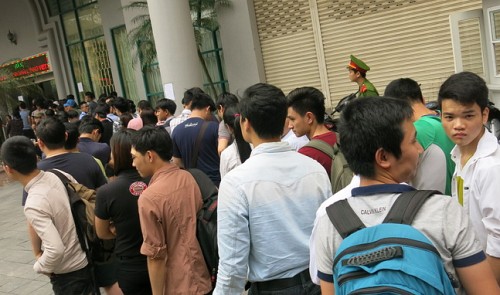
Residents in the Vietnamese capital made a queue for the country’s newly issued 100-dong commemorative banknote on Wednesday at the central bank’s headquarters.
Earlier, the State Bank of Vietnam (SBV) issued a souvenir bill with a denomination of 100 Vietnamese dong on Tuesday in commemoration of its 65th anniversary (1951-2016).
The bill features the most iconic spiritual, historical, and cultural symbols of the Southeast Asian country, and was printed using the most advanced money-printing technologies fully-funded by foreign sponsors, the bank’s vice governor said.

A single banknote of this bill costs VND20,000 (US$0.92), while its folder edition that comes with a bilingual detailed caption fetches VND25,000 ($1.14) each.
Though it was already the second day the bank had begun selling the note, hundreds of locals were still seen queuing outside the SBV’s headquarters on Tong Dan Street, Hoan Kiem District, Hanoi, in the afternoon to get hold of the commemorative bill.
This was due to the fact that the other SBV branch in Hanoi had earlier stopped receiving new registrations for the bill, luring all buyers to its headquarters.
Howard Daniel writes:
I also received two more emails about the State Bank will be sponsoring a national numismatic society! This is big news because only philatelics was an approved national hobby with a society.
Every time I meet someone from inside the State Bank or outside it with influence in the government, I have talked to them about the state bank and its branches selling coins and notes to their people and to overseas customers; and about creating a museum and the society. One of them was the former Chief of Staff in the State Bank and I saw him taking notes as I spoke. Maybe he set everything in motion about five years ago, which is likely about what a project takes to get done in Viet Nam.
To read the complete article, see:
Hanoi residents dash to buy
commemorative Vietnamese bill (http://tuoitrenews.vn/business/34280/hanoi-residents-elbow-to-buy-commemorative-vietnamese-bill)
To read the earlier E-Sylum article, see:
VIETNAM PLANS TO ISSUE COMMEMORATIVE BANKNOTE
(www.coinbooks.org/esylum_v19n15a34.html)
EDMONTON REMOVES LAST COIN-OPERATED PARKING METERS
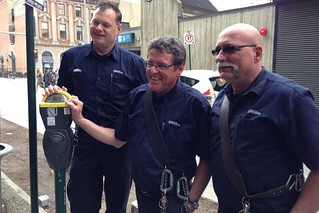 For the first time in 68 years, Edmonton doesn’t have a single coin meter.
For the first time in 68 years, Edmonton doesn’t have a single coin meter.
The city said goodbye to its final coin meter on Tuesday, marking a complete embrace of EPark.
Edmonton’s parking meters first popped up on July 26, 1948 downtown. A penny in a parking meter would let a driver park for 12 minutes back then and a nickel for an hour. Fines were $1.
Since the EPark trial ended in 2014, more than 375 EPark machines have replaced 3,300 coin meters...
The old coin meters are for sale at $100 per meter. Those who are interested in buying one can contact 311 by May 31.
The city wants to sell the rest of the meters to another municipality.
To read the complete article, see:
Edmonton says goodbye to last coin parking
meter (http://globalnews.ca/news/2636356/edmonton-says-goodbye-to-last-coin-parking-meter/)

FEATURED WEB SITE: THE CURRENCY COLLECTOR
This week's Featured Web Site is John Sandrock's site, the Currency Collector, suggested by Kavan Ratnatunga. Thanks!In order to be a true numismatist I believe one must look beyond collecting for collections' sake alone. True knowledge comes from researching the history and stories behind the currency, as they often reveal fascinating insights into the "why, where and when" of the economic, political and social issues of their time. It is in this spirit that the articles contained in this website, written over sixty years of collecting, are offered.
In addition to oriental coins and the currencies of the world my collecting interests include old newspapers and other related historic documents. I have been a contributor to various numismatic publications and am the author of Copper Cash and Silver Taels, a book covering the monetary aspects of life in China during the Ch'ing dynasty.

Kavan writes:
I found particularly interesting
1) An article on Stamps on Currency notes which acted almost like counter marks on coins at times of emergency need.
2) An article on The Worlds First Paper Money.
www.thecurrencycollector.com

